

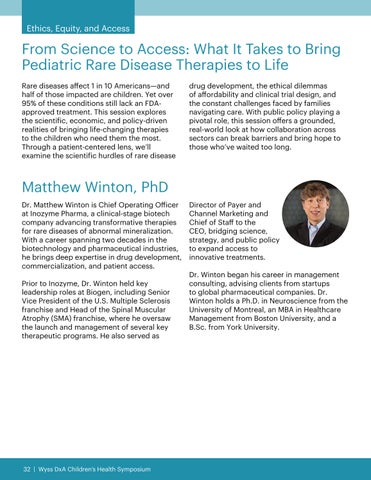


June 3, 2025
Wyss Institute
Boston, MA


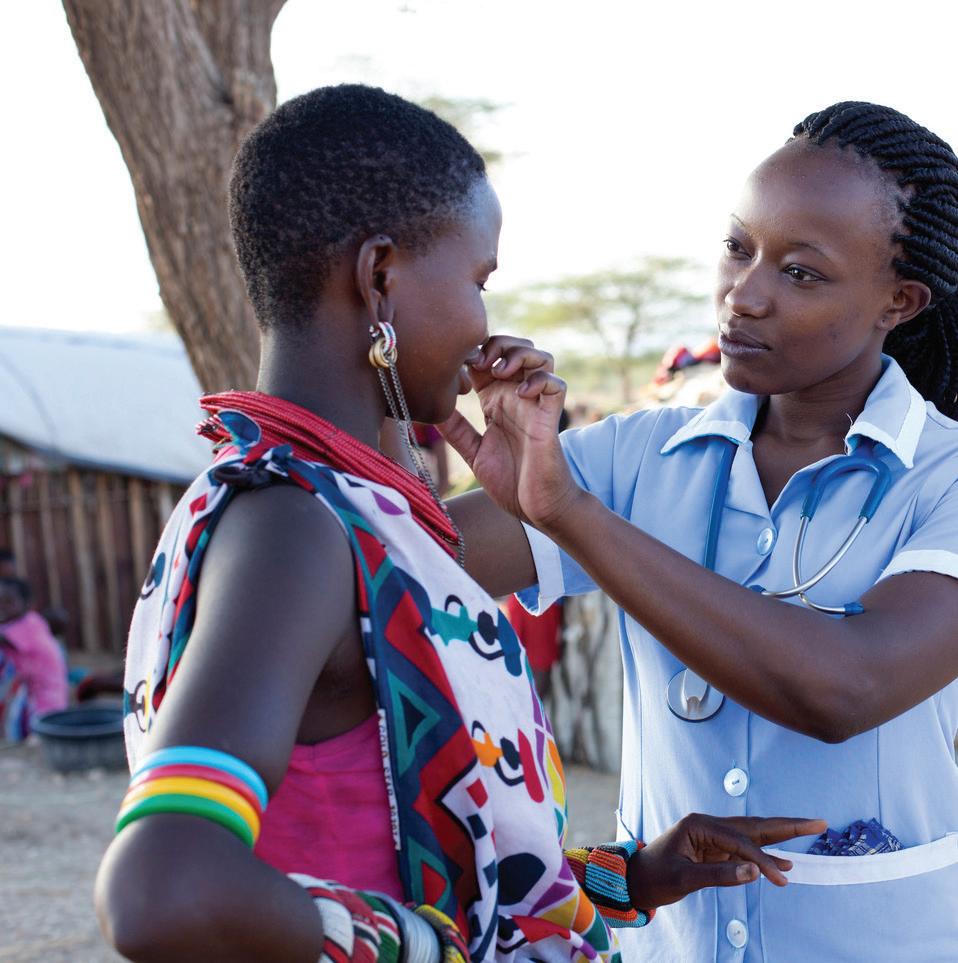
The Wyss Diagnostics Accelerator (Wyss DxA) is an initiative that enables the fast creation of diagnostic technologies to solve high-value clinical problems through deep collaborations driven by unmet diagnostic needs.
Our mission is to enable efficient and effective delivery of diagnostics to reduce global disease burden.

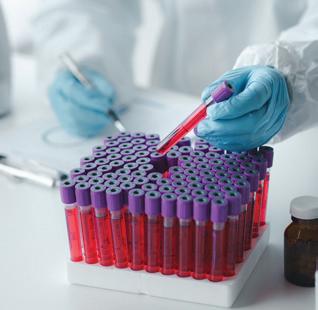



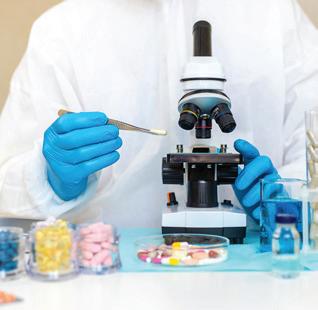
Preventing Tomorrow’s Illness Today: Innovations Shaping a Healthier Future for Every Child
Faster Answers, Better Futures: Transforming Pediatric Care Through Next-Gen Diagnostics
Building the Tools to Reveal More: Breakthrough Platforms Driving Pediatric Health Discovery
Centering Justice in Children’s Health: Bridging Innovation, Inclusion, and Impact
Fueling Big Ideas for Small Patients: Financing and Scaling Innovation in Children’s Health
Designing Tomorrow’s Treatments: Breakthrough Therapies Tailored for Pediatric Lives
8:45 AM 10:30 AM 1:00 PM 1:40 PM
2:45 PM
4:00 PM
7:00 AM
8:00 AM
8:20 AM
Registration and Breakfast
Welcome Remarks
Rushdy Ahmad, Wyss Institute
David Walt, Wyss Institute
Angelika Fretzen, Wyss Institute
Nan Doyle, Trillium Advisors
Keynote Address
Global Overview on Perinatal Health: Imaging Innovations and the Role of AI
Ellen Grant | Boston Children’s Hospital
8:45 AM
Prevention
Challenge of AMR for children’s health and opportunities for the future
Michael Gilmore | Mass Eye and Ear Institute
Influenza Vaccination and What it Teaches us About the Pediatric Immune System
Brett Leav | Moderna
Identification of treatable genetic disorders in fetuses and newborns
Nina Gold | Massachusetts General Hospital
Broadly-neutralizing antibodies as an alternative treatment modality for infants living with HIV
Mathias Lichterfeld | Ragon Institute
Lifting Early Development: Virtual-First Prevention that Empowers Families and Changes Trajectories
Mitch Mudra | Ladder Health
Vaccines and therapies for bloodstream infections in children
Michael Super | Wyss Institute
Mimicking Mother Nature to Prevent Childhood Allergic Disease
Richard Insel | University of Rochester Medical Center
10:10 AM
Coffee Break
10:30 AM
Why Ultrasensitivity Matters for Clinical Diagnosis
David Walt | Wyss Institute
Unique Considerations for the Diagnosis of Rare Disease: Challenge, Solutions, and More Challenges
Neil Inhaber | Takeda
Novel approaches to the detection and prediction of suicidal behavior
Matt Nock | Harvard University
The Need for Rapid Diagnostic Tests for Congenital Syphilis
Lao-Tzu Allan-Blitz | Harvard Medical School
Innovations in Diagnostic Development: CARB-X’s Role in Addressing Neonatal Sepsis
Betsy Wonderly | CARB-X
Diagnostics Keynote Address
Unmet and poorly-met diagnostic needs for childhood infections
Mark Miller | bioMérieux, former CMO
Lunch 12:00 PM
1:00 PM
Discovery Platforms
Developing a diagnostic for neonatal sepsis
Louise Hansen | Wyss Institute
Expanding Pediatric Genetic Testing to Low-Resource
Communities: Bridging the Gap
Tan Rasab | SiGenex
Towards diagnosing pediatric tuberculosis using Molecular Onbead Signal Amplification for Individual Counting
Shira Roth | Wyss Institute
Building an automated extracellular vesicle (EV) profiling platform for biomarker discovery
Dima Ter-Ovanesyan | Wyss Institute
Proteomics-Driven Biomarker Discovery for Pediatric NEC: A Platform Approach
Bogdan Budnik | Wyss Institute
1:40 PM
Ethics Keynote Address
What can be done to ethically accelerate research in pediatric rare disease
Arthur Caplan | New York University
From Science to Access: What It Takes to Bring Pediatric Rare Disease Therapies to Life
Mathew Winton | Inozyme Pharma
Mobilizing Biotech for Silent Epidemics of Environmental Exposures: Leading with Childhood Lead Poisoning
Daniel Goodwin | Homeworld Collective
The Hidden Epidemic: Uncovering the Reality of Fetal Alcohol Spectrum Disorders (FASD)
Constance Mazelsky | Patient Advocate
2:45 PM
Financing and Scaling Innovation
From Philanthropy to Venture Capital: Driving Impact and Investment Success in Pediatric Innovation
John Parker | Springhood Ventures
Scaling Pediatric Clinical Research: The Power of Real-World Data from Hospitals Worldwide
Gadi Lachman | TriNetX
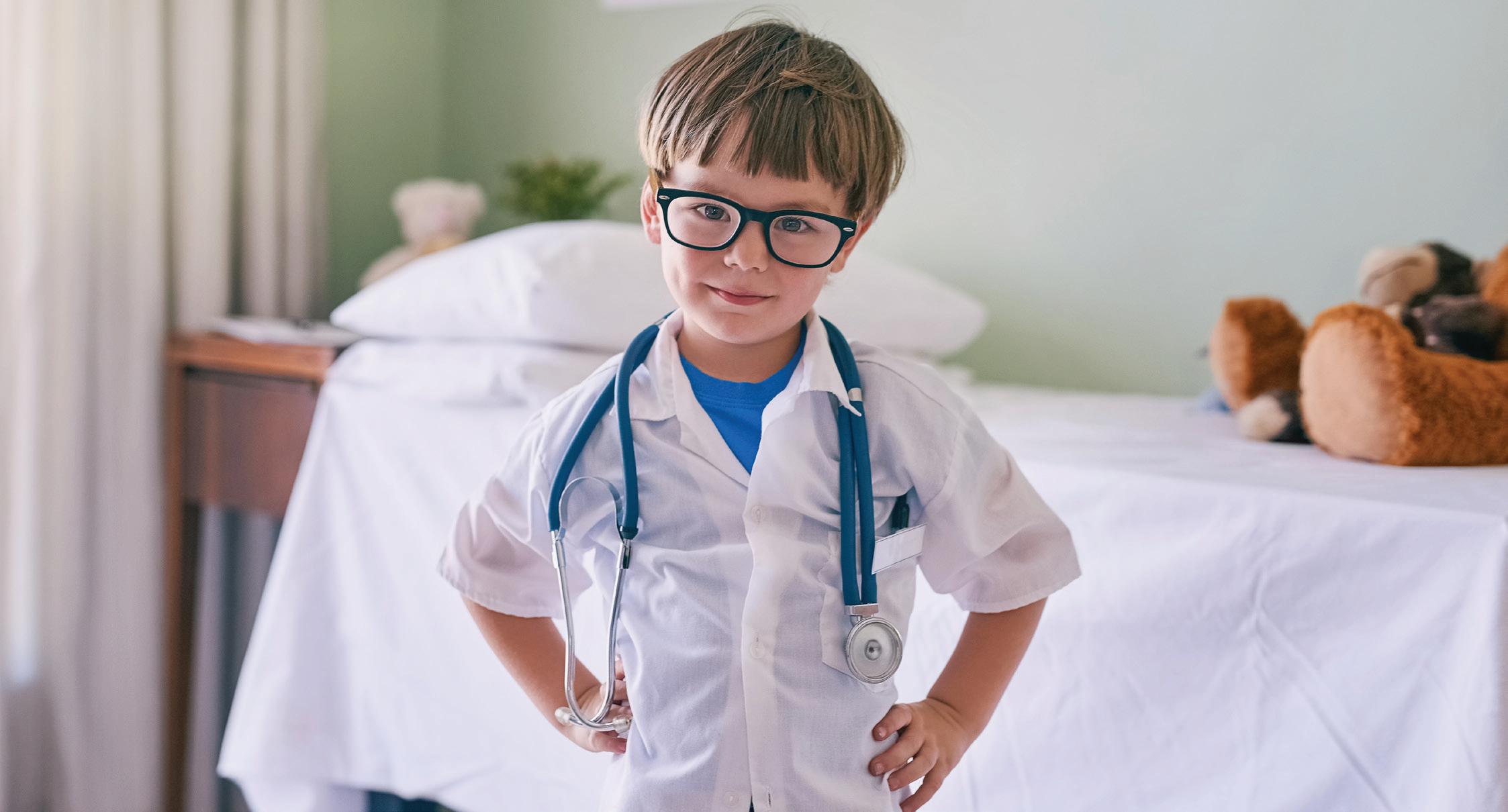
3:10 PM Prevention Highlight
Co-Regulation as Prevention: Building Relational Safety in Pediatric Care
Thomas Hübl | Wyss Institute Visiting Scholar
3:30 PM
Coffee Break
4:00 PM
Therapeutics
Mouse Models for Rare Disease: Why you need them and how to use them
Cathleen Lutz | The Jackson Laboratory
Unraveling diseases toward therapies: patient-driven drug development
Richard Novak | Unravel Biosciences
Novel Therapeutic Strategies for Pediatric Food Allergy: Microbiome and Biologic Approaches
Rima Rachid | Boston Children’s Hospital
Leveraging Artificial Antigen-Presenting Cells for the Development of T-cell Receptor Immunotherapy for Pediatric Solid Tumors
Yoav Binenbaum | Wyss Institute
Modeling Contributions to Preterm Labor in A Human Cervix Chip Anna Stejskalova | Wyss Institute
Prapela, the first and only FDA-Authorized Device to Treat OpioidExposed Newborns
John Konsin | Prapela, Inc
Polymeric Microneedles for Biomarker Sampling and Therapeutic Delivery in Pediatric Patients
Natalie Artzi | Wyss Institute
Final Word 5:30 PM
Why Invest in Children?
Sandra Fenwick | Boston Children’s Hospital, emerita CEO
Reception 5:40 PM
Rushdy Ahmad, Ph.D. is the Director of the Wyss Diagnostics Accelerator (Wyss DxA) at Harvard’s Wyss Institute, where he leads efforts to accelerate the discovery and translation of life-saving diagnostics. With over 20 years of experience as a biomarker hunter, his work is deeply rooted in a personal mission shaped by three powerful drivers: women’s health, infectious disease, and child health.
That mission began in childhood. During the Bangladeshi war of independence, Rushdy, an infant, his mother, uncle, and baby brother fled through rice and paddy fields under the cover of night to India. Both Rushdy and his brother became gravely ill during their escape, and survival came only through the care of a compassionate doctor—who through privileged access, was also the physician to the President of India. Though too young to remember the ordeal, the story was etched into family memory and became formative in shaping his purpose. Growing up in Bangladesh, he saw firsthand the impact of health inequities—especially among children and women. A housekeeper’s battle with tuberculosis (TB) left a lasting impression, as did the work of his mother, an academic historian and fierce advocate for women’s rights, and his maternal grandmother, the first female gynecologist in her region.
These early influences continue to drive his work today. After earning his Ph.D. in experimental particle physics from Brown University and
contributing to the Nobel Prize-winning resolution of the solar neutrino problem, Rushdy made a pivotal decision. Following the death of his father-in-law from lung cancer shortly after the birth of his first child, he left a career in software engineering to devote himself fully to biomarker discovery and translational diagnostics. His postdoctoral training at Boston University School of Medicine and subsequent work at the Broad Institute of MIT and Harvard allowed him to master clinical proteomics across a wide range of diseases.

Since joining the Wyss Institute just before the COVID-19 pandemic lockdown in March 2020, Rushdy has helped lead the global response as head of the direct-to-consumer diagnostics group at the Mass General Brigham Center for COVID Innovation. He went on to establish the BrighamWyss DxA and its Industrial Participant Program (IPP) in 2021, followed by the launch of the Biomarker Discovery Laboratory (BDL) in 2022.
Through these initiatives, he continues to help translate molecular insights into diagnostic solutions that can also reach underserved populations—always guided by the belief that science must serve those who need it most. For Rushdy, diagnostic innovation is not just a professional calling; it is a personal obligation shaped by history, family, and the urgent needs of the present.
Trey Toombs is the Head of Operations for the Wyss Diagnostics Accelerator (DxA), where he fosters and supports collaborative research programs between technology developers, clinicians, industry partners and other key stakeholders. With his decades of experience in research and program development, Trey helped launch and operationalize the DxA to enable the advancement of innovative diagnostics. Previously, he served as the Program Director for the Brigham Research Institute where he worked closely with faculty and institutional leaders to develop
As Principal of Trillium Advisors, Nan Doyle helps emerging companies embed patient perspective into every nook and cranny of rare-disease drug discovery and development, with enriched expertise in genomic modalities that may address the underlying cause of disease. Insight into the natural history of a disease, which symptoms patients find most concerning, how they gauge benefits and risks of treatment, what trial designs are manageable, and whether consent forms or other materials are understandable, can help accelerate availability of new treatments and foster trust. Payers, regulators, and investors increasingly seek patient perspective to derisk their decisions; and patients themselves are keen to partner.
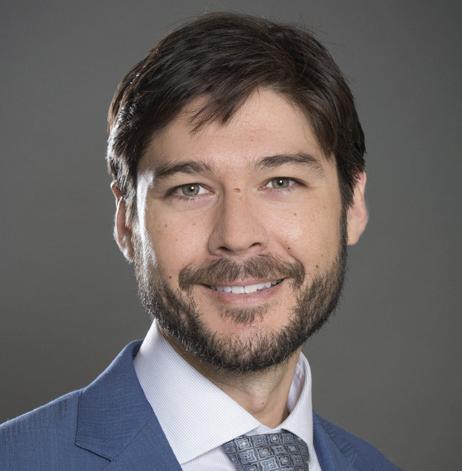
initiatives that support interdisciplinary research and raise the visibility of the research enterprise at Brigham and Women’s Hospital. Trey received a B.S. from Virginia Tech, a Ph.D. in biochemistry and molecular biology from Colorado State University, did a postdoctoral research fellowship at Massachusetts General Hospital and completed executive leadership training at Harvard Business School.
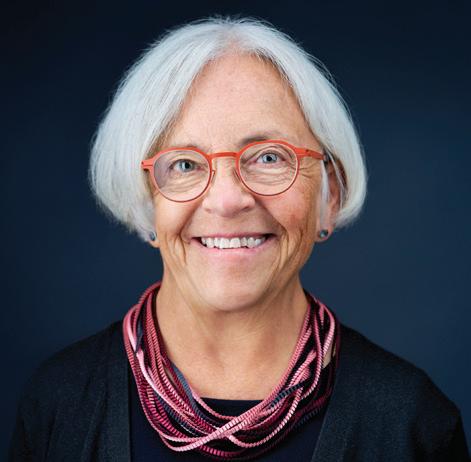
Nan is a board-certified genetic counselor who’s held innovative, successful roles connecting patients with the science that may help them. She’s worked with bright lights in rare disease medicine including Takeda, Alnylam, Genzyme, Massachusetts General Hospital, the Boston Museum of Science, Parexel, and Harvard Medical School. She holds Master’s degrees in genetic counseling and marketing/ mass communication from Boston University and a BS in pre-veterinary science from the University of Delaware.

As Chief Operating Officer and Technology
Translation Director at the Wyss Institute, Angelika Fretzen, Ph.D., M.B.A., is passionate about uniting and stewarding powerful teams as they work to solve the most pressing problems facing our society in healthcare and sustainability.
Throughout her career, it became evident to Angelika that the strength and health of women was integral to their own perspective on life, to their families, and to the societal ecosystem they participated in. Her deep commitment to bridging the acute healthcare and equity gap for women that we still face is evident in her championing the development of programs and technologies to address these gender-based issues. At the Wyss, she initiated the Wyss 99s that aims to encourage, develop, and provide resources to female leaders, entrepreneurs, and scientists. Through her passion of working towards health equity, Angelika was the impetus for the formation of the Women’s Health Catalyst with a vision of developing entirely innovative approaches to studying female biology and creating technologies to define healthy and disease responses that change dynamically over time much like a woman’s own physiology. In 2024, she received the prestigious Joseph B. Martin Dean’s Leadership Award for the Advancement of Women’s Careers at Harvard Medical School/Harvard School of Dental Medicine.
Before coming to the Wyss, Angelika spent two decades in entrepreneurial pharmaceutical companies where she developed a deep commitment to improving healthcare for women and families.
At Ironwood Pharmaceuticals, she spearheaded the discovery, development, and commercialization of Linzess™, a first-in-class medication for Irritable Bowel Syndrome, a symptomatic disease that can be debilitating to many women in the most productive years of their life. Prior to the development of this therapeutic, effective treatment options were nonexistent until Linzess™ became available to physicians. At Catabasis Pharmaceuticals (now Astria TX), Angelika collaborated closely with the internal team, clinicians, advocacy groups, and families to bring Edasalonexent into Phase 3 clinical trials for the treatment of Duchenne Muscular Dystrophy, a rare genetic neuromuscular disease that affects young boys and their families. For 12 years, she also served on the Board of Bridgewell, a social and human service organization, where she facilitated programs for the homeless, individuals with disabilities, young adults with autism, and young mothers with a history of substance abuse.
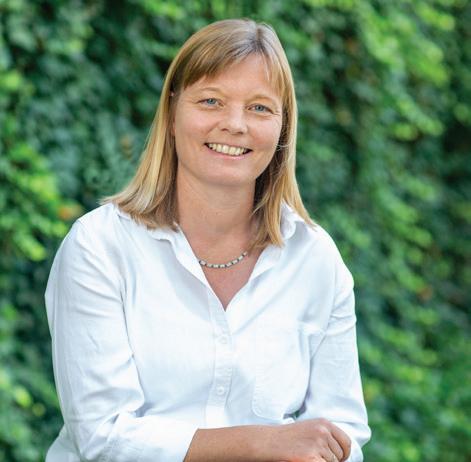
Angelika Fretzen is a chemist by training, completing her undergraduate studies in Germany and her Ph.D. in Switzerland. She came to the United States for her postdoctoral research at Harvard University, before joining the early biotechnology community in Kendall Square in 2000. She holds an M.B.A. from Suffolk University and is deeply committed to both the personal and career development of all scientists and employees around her. She was named one of Mass High Tech’s 2013 “Women to Watch” by the Boston Business Journal.
Emerging evidence highlights the profound impact of fetal and early childhood development on lifelong health trajectories. Rapid advances in fetal imaging, whole genome sequencing, and prenatal surgical interventions have transformed the standard of care, with fetal surgery now routine for select life-threatening conditions. Increasing understanding of the dynamic interplay between placental function, fetal brain development, and hypoxic stress underscores the need for predictive and personalized approaches to perinatal care. This presentation will spotlight innovative technologies, including portable MRI and
emerging optical neuromonitoring tools that bring bedside brain assessment to neonates, with significant potential to improve outcomes in low- and middle-income countries. We will also explore the transformative role of artificial intelligence (AI) in fetal and neonatal care— from anomaly detection and neuromotor tracking to outcome prediction in conditions such as hypoxic-ischemic encephalopathy (HIE). Finally, we will address key challenges in model generalizability and the critical need for diverse, openly shared datasets to ensure equitable and scalable AI-enabled solutions in global perinatal health.
Dr. Grant is the Käthe Beutler, MD Harvard Professor of Pediatrics and Professor of Radiology, Harvard Medical School. She is a practicing Pediatric Neuroradiologist, Director of Faculty Affairs for the Department of Radiology, Director of Research for the Fetal Care and Surgery Center and founding Director of the Fetal Neonatal Neuroimaging and Developmental Science Center (FNNDSC) in the Departments of Pediatrics and Radiology. The Fetal-Neonatal Neuroimaging and Developmental Science Center (FNNDSC) comprises a multidisciplinary team of over 70 members, including 17 PhD faculty investigators and 7 postdoctoral fellows. The Center’s research portfolio integrates advanced magnetic resonance imaging (MRI), optical imaging, magnetoencephalography (MEG), and artificial intelligence (AI) methodologies. FNNDSC investigators are
committed to pioneering technical innovations while emphasizing the clinical translation of novel imaging technologies to enhance diagnostic and therapeutic strategies for fetal, neonatal, and pediatric populations. Dr Grant served on the Board of Scientific Counselors for NICHD from 2020 - 2024, received the Outstanding Contributions in Research Award from the American Society of Neuroradiology in 2021 and received the Gold Medal Award from the American Society of Pediatric Neuroradiology in 2022. She is currently a Senior Fellow of the International Society of Magnetic Resonance in Medicine (ISMRM), has published over 300 articles, has an h-index of 79 with over 25,000 citations and is PI on 9 major NIH awards.
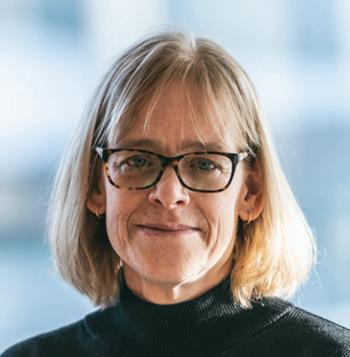
The impact of the global challenge of antibiotic resistance is especially acute for populations at extremes of the age spectrum. With evolving immune systems, children suffer high rates of ear, throat and upper respiratory infections and are prescribed antibiotics at rates of about 1 prescription per year through the first 5 years. Antibiotic prescriptions are often given without specific pathogen diagnosis or antimicrobial susceptibility testing, and are often for broad spectrum drugs affecting much of the child’s microbiota and further stoking the development of resistance and colonization by resistant microbes.
Currently Chief Scientific Officer, Mass Eye and Ear/Mass General Brigham and Sir William Osler Professor of Ophthalmology (Microbiology), Harvard Medical School, Mike also serves as Director of the Infectious Disease Institute, and as Co-Director of the Microbial Sciences Initiative of Harvard University. Additionally, he is a Senior Associate Member of the Broad Institute. As Principal Investigator of the NIHfunded Harvard-wide Program on Antibiotic Resistance, his research focuses on the evolution and development of multidrug resistant strains of enterococci, staphylococci, and streptococci, and the development of new therapeutics for treating infections of the eye, ear and other anatomical sites. He was named in “The Heroes of CRISPR” (Cell 2016 164(1-2):18-28.) as inspiring Broad Institute scientist interest in developing CRISPR as a tool for therapeutic gene editing. Mike has trained over 35 graduate students and postdocs, and is currently course coordinator and principle lecturer in OEB290/MICRO210 Microbiology: Chemistry, ecology and evolution. Outside of Harvard, he currently serves on the Board of Directors of the American Society for Microbiology (ASM), and is past chair of the NIH Bacterial Pathogenesis Study Section, the Gordon Conference on Microbial Adhesion and Signal Transduction, American Society for Microbiology (ASM) Division D, and the Association for Research in Vision and Ophthalmology (ARVO) IM Section.
Further complicating the challenge, many newer drugs are not initially tested in children, and rapid bone growth and developing cytochrome detoxification systems further limit the use of several classes of compounds. Meeting this challenge will require an integration of advances in diagnostics and stewardship, together with progress in drug discovery and development, targeted delivery, vaccinology and advances in other technologies for successfully managing the interactions between the pediatric population and the many microbes they are exposed to as their immune systems develop.
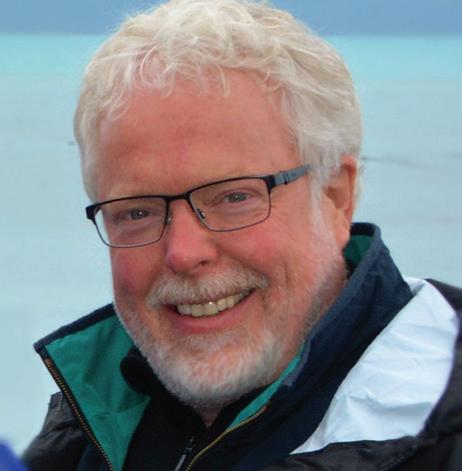
Mike is founder of the International Conference on Enterococci (ICE) series, and the Boston Area Antibiotic Resistance Network (BAARN). He recently served as chair of the US National Institutes of Health (NIH) blue ribbon panel for the Antimicrobial Resistance Diagnostic Challenge; and of Scientific Advisory Boards for the Zentrum für Infektionsforschung, University of Wuerzburg, and the Center for Antimicrobial Resistance and Therapeutic Discovery at Brown University. He started his academic career in 1984 at the University of Oklahoma Health Sciences Center, where he rose through the ranks to Vice President for Research. He also held the MG McCool professorship and was awarded the George Lynn Cross research chair. In 2004 he moved to Harvard Medical School as President and CEO of the Schepens Eye Research Institute, Marie and DeWalt Ankeny Director of Research and CL Schepens Professor of Ophthalmology. In 2010, he moved his laboratories to the Massachusetts General Hospital campus, in the Massachusetts Eye and Ear Infirmary. He has published over 200 peer reviewed manuscripts in Cell, Nature, Science, PNAS and other leading journals. He continues to serve on numerous advisory boards and committees for public and private organizations focused on drug discovery, antibiotic resistance, and bacterial pathogenesis.
Influenza impacts the bookends of life; children and older adults. During the 20232024 influenza season, there were an estimated 470,000 hospitalizations and 28,000 deaths in the United States. While the burden of disease is highest in older adults, children and younger adults are impacted but also have a significant role in disease transmission. Furthermore, during pandemics the pattern of disease susceptibility can shift with greater morbidity and mortality affecting the young. This epidemiology forms the basis
Brett Leav, MD is Executive Director of Clinical Development for Public Health Vaccines at Moderna, with responsibility for overseeing the Global and Public Health Vaccine portfolio. Dr. Leav joined Moderna in April 2020 and before assuming his current role, led the Moderna COVID-19 vaccine clinical program in adults and children, where he was able to contribute his deep knowledge and experience in vaccine development to address this global crisis. As Executive Director for Global and Public Health Vaccines, Dr. Leav currently oversees the clinical development of mRNA vaccines intended to prevent intractable infectious diseases and potential pandemic pathogens.
Prior to joining Moderna, Dr. Leav led clinical development of novel seasonal influenza vaccines at Seqirus (CSL) and Novartis, where his team designed and conducted clinical trials for global licensure including the FDA approval of the first adjuvanted seasonal influenza vaccine, Fluad®. Dr. Leav’s interest in vaccines began during his tenure as a clinician and researcher at Tufts Medical
for the recommendation and practice in the US for annual vaccination to begin at the age of 6 months. In contrast, outside of the United States, children and younger adults are not routinely vaccinated. One reason for this is that the currently available vaccines are estimated to be only 50 – 60 % effective in preventing medically attended influenza. More effective influenza vaccines are needed, and I will review some novel vaccine technologies that may address this unmet need.
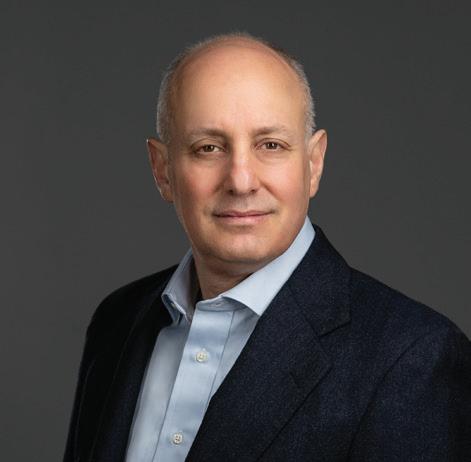
Center, where he served as Principal Investigator of an NIH-funded research effort to understand the mucosal immune response to the enteric pathogen, Cryptosporidium parvum. He then applied his knowledge of immunology to the development and regulatory approval of monoclonal antibodies against rabies and Clostridioides difficile at MassBiologics, a nonprofit, FDA-licensed manufacturer of vaccines. He is an author of more than 50 peer-reviewed publications resulting from his work.
Dr. Leav received his medical degree from the University of Massachusetts in Worcester, Massachusetts. He completed his internal medicine residency at Georgetown University Medical Center in Washington DC and his fellowship in Geographic Medicine and Infectious Diseases at Tufts Medical Center after practicing primary care internal medicine for several years in Waltham, Massachusetts. He maintains board certification in Infectious Diseases.
Over the past decade, genomic screening of newborns has become a major focus of international research. Yet, determining which genes to include remains a complex challenge. We have begun to address this by engaging key stakeholders and developing data-driven machine learning models that rank high-priority disorders for genomic newborn screening. Additionally, genomic sequencing is being increasingly used in clinical care to understand the genetic causes of sonographic abnormalities detected during pregnancy.
Dr. Gold is a clinician-researcher focused on expanding genomic screening for treatable genetic conditions, particularly in newborns and children. She is a practicing medical geneticist and biochemical geneticist at Massachusetts General Hospital (MGH), where she serves as Associate Director of Research for the Mass General Brigham Biobank, Director of Prenatal Medical Genetics, and Director of Metabolism.
Her research blends implementation science and bioinformatics to improve screening approaches for rare genetic disorders across all ages. She is funded by a K08 award from the National Human Genome Research Institute and the MGH Claflin Distinguished
However, many treatable genetic conditions do not cause visible abnormalities but still carry significant health implications for the fetus or newborn. In this talk, Dr. Gold will explore the continuum between newborn and fetal health and present a proposed framework for a “treatable fetal findings list.” To address questions about the positive predictive value of such a list, examples from genomic screening of adults with disease-associated variants will also be discussed.
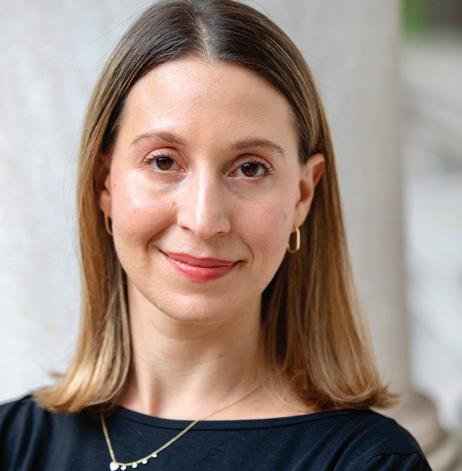
Scholars Award. She is also a co-investigator on BabySeq II, a randomized trial of whole genome sequencing in newborns. She is committed to advancing genomic screening through methods that are clinically useful, equitable, and scalable.
Dr. Gold received her MD and a Master of Medical Bioinformatics degree at Harvard Medical School. She completed a combined residency in pediatrics and medical genetics at Boston Children’s Hospital and a fellowship in medical biochemical genetics at the Children’s Hospital of Philadelphia.
Pediatric HIV-1 infection can occur by vertical transmission in utero, during childbirth, or through breastfeeding, and currently affects more than 2.5 million children and teenagers worldwide. While antiretroviral agents for pediatric use are now readily available in most parts of the world, they are typically not formulated as single-pill regimens and can be associated with pronounced side effects and marked adherence challenge. As a result, fewer infants and children achieve viral suppression than adults and the mortality rate for pediatric HIV-1 infection remains high, even when antiretroviral therapy (ART) is initiated early in life. Broadly neutralizing antibodies (bnAbs) are an emerging treatment modality for people living with HIV-1 and can effectively suppress HIV-1 plasma viremia in adults with susceptible viral strains. Potential advantages of bnAbs over standard smallmolecule ART include less frequent dosing, reduced long-term toxicities, and the putative ability of bnAbs to engage host immune responses against HIV-1 reservoir cells that persist despite antiretroviral therapy. We conducted a detailed analysis of proviral
reservoir dynamics and antiviral immune responses in a unique group of young children from Botswana who started ART at birth and then stopped standard ART while receiving the two bnAbs 10-1074 and VRC01-LS in a prospective clinical trial. No quantitative changes in proviral sequences were observed during bnAb treatment, but selection of genome-intact proviruses in transcriptionallyrepressive heterochromatin regions occurred in some study participants. Higher proviral frequencies and increased probabilities of viral rebound were linked to expression of HLA-C2 and to elevated proportions of KIR2DL1positive NK cells. In contrast, delayed viral rebound and more limited viral reservoir size were associated with increased proportions of NKG2A-positive NK cells and with the HLA-B -21M signal peptide polymorphism. HIVspecific T cell responses were low in all study participants and unrelated to viral reservoir sizes or clinical outcomes following ART interruption. Together, these data suggest that clinical effects of bnAbs in young children are partly modulated by NK cells.
Dr. Mathias Lichterfeld is an infectious disease physician who works as a basic science and translational investigator, a clinical care provider, and a mentor and educator for residents and clinical/research fellows. Dr. Lichterfeld is a Professor of Medicine at Harvard Medical School and Co-Director of the Harvard University Center for AIDS Research (CFAR) Program on HIV Eradication.
He is also a senior staff physician in the Infectious Disease Division of Brigham and Women’s Hospital (BWH) and MGH; a Member of the Ragon Institute of Mass General, MIT, and Harvard; and an Associate Member of the Broad Institute of MIT and Harvard.

Early childhood presents a rare and powerful window to influence lifelong developmental, behavioral, and health outcomes. But too often, children at risk for delays—especially those covered by Medicaid or facing social determinant barriers—miss the opportunity to access timely, high-impact intervention. Over 55% of children with developmental delays rely on Medicaid, yet fragmented systems and rigid schedules leave many without the care they need, when they need it most.
At Ladder Health, we’re reimagining early developmental care by combining evidencebased developmental therapy with a virtualfirst, caregiver-empowered model.
Mitch Mudra is the CEO of Ladder Health (ladderhealth.co), a company reimagining care for young children with developmental delays through proactive, holistic, and familycentered care. Built with Boston Children’s Hospital, Ladder Health is breaking barriers to early childhood health and development— with a vision of a different future where every child thrives. Ladder’s model combines early detection, caregiver support, and longitudinal care to address developmental challenges during the most critical window of a child’s life.
Prior to Ladder, Mitch served as Global Chief Operating Officer and U.S. Healthcare President at Sidekick Health, a leading international digital therapeutics company,
Our approach supports children and families across motor, language, cognitive, socialemotional, and adaptive domains during critical neurodevelopmental windows. By meeting families where they are—often in the evenings and weekends when families are actually available, both logistically and emotionally, we not only expand access to underserved populations but also help caregivers become confident, capable partners in their child’s progress. This talk explores how scalable, interdisciplinary early intervention—delivered at home, on the family’s schedule—can shift life trajectories and reduce downstream behavioral, educational, and healthcare burdens.
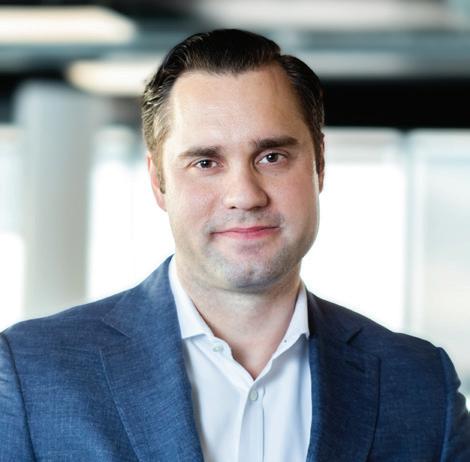
where he led the design and deployment of evidence-based digital care programs for chronic and preventive conditions. He also spent over 15 years at UnitedHealth Group and Optum, where he held senior leadership roles focused on building and scaling innovative healthcare solutions across payer, provider, and technology ecosystems.
Mitch brings deep expertise in health system transformation and a passion for advancing equity and impact in vulnerable populations— especially through earlier identification, prevention, and intervention for children and families.
Sepsis is the most common cause of death in infants and children worldwide. Childhood pneumonia has an estimated incidence of 0.29 episodes per child-year in pre-developed and 0.05 episodes per child-year in developed countries, making it the most common cause of pediatric sepsis; it is also the leading cause of mortality in children less than 5 years of age (Randolph & McCulloh). Therefore, life-saving medical solutions to overcome sepsis and blood stream infections (BSI) can significantly impact clinical outcomes for both infants and children. Importantly, there are no approved vaccines for the most common pathogens causing sepsis and BSI, including gram negative E. coli, gram positive S. aureus, or the methicillin resistant form of S. aureus (MRSA). There have been many failed attempts, but the glycosylated antigens and capsules of bacteria are poorly immunogenic.
Michael Super is the Director of ImmunoMaterials and a Senior Scientist on the Advanced Technology Team at the Wyss Institute.
Super’s research leverages protein engineering to design therapeutic and diagnostic devices to treat cancer, and infectious and immunological diseases. Prior to joining the Wyss, Super spent 17 years in the Biotechnology industry, employed in companies ranging from start-ups to large Pharma. In industry, Super was the Director of
Researchers at the Wyss Institute have developed technologies biomaterial scaffold vaccines and therapeutic solutions to BSI and sepsis. We have used engineered human lectins conjugated to biomaterial surfaces to capture pathogen PAMPs (Pathogen associated molecular patterns) - the glycosylated antigens on the cell walls of pathogens including viruses, bacteria and fungi, and present these to the host immune system in the presence of immune stimulating molecule. With these technologies we have protected mice, rabbits and pigs from sepsis and septic shock.
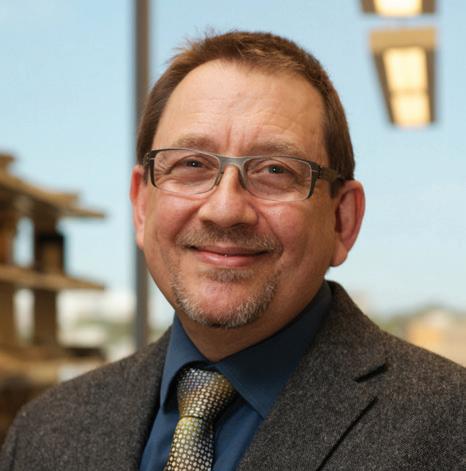
the Protein Biochemistry, Immunobiology and Hybridoma Antibody groups, focusing on the design, development and production of therapeutic antibodies for cancer and autoimmune disease therapy. Super received his M.Sc. in Biomolecular Organization at Birkbeck College and his Ph.D. in Medical Immunology at the Institute of Child Health, University of London, followed by postdoctoral work at Harvard in Hematology/Oncology and Infectious disease.
Modernization has been associated with an increase in chronic, non-communicable diseases (NCDs) in children and adults, including allergic diseases. Although NCDs may manifest clinically throughout the life course, several NCDs that first manifest in childhood or even adulthood arise from environmental interactions occurring in the first 1000 days of life. Several hypotheses to explain the environmental components contributing to the increased prevalence of allergic diseases include the Epithelial Barrier Hypothesis, which proposes that exposure to barrier damaging agents promotes a proinflammatory state in the skin or at mucosal surfaces, and the Hygiene Hypothesis and its variants, which posit that an unhealthy or dysbiotic gut microbiota impairs immunoregulation or immune tolerance. The neonate is born with a vernix that provides physical and antimicrobial protection to the skin in-utero and after birth when neonatal skin undergoes major changes arising from the transition from an in-utero environment. To protect the skin during this early neonatal and infant period, an emollient was used to replace the vernix starting in the first 4 days after birth and continuing for 2 months in high-risk neonates in the STOP AD clinical trial. Use of the emollient decreased the cumulative incidence of atopic dermatitis (AD) in the first year by 30% and the point prevalence of AD
Richard Insel, MD is currently a Research Professor in the Department of Pediatrics at the University of Rochester School of Medicine & Dentistry. From 2016 to 2024 he held various positions at Johnson & Johnson (J&J), including Head of Child Health & Wellness at Kenvue (consumer-sector spinout of J&J) (2023-2024), Global Head, Healthy Baby Initiative (HBI), World Without Disease Accelerator (WWDA), Janssen (2019-2023), consultant to WWDA (2016-2019). As Global Head of the HBI, he led a strategy focused on changing the trajectory of health for children with a focus on prevention of childhood allergic diseases by targeting their root cause. From 2003 to 2016, he served roles as Executive Vice President of Research and Chief Scientific Officer at the Juvenile Diabetes Research Foundation (JDRF), where he oversaw
at 6 and 12 months by ~50%. Bifidobacterium and the species Bifidobacterium longum subsp. infantis (B. infantis), keystone, pioneer microbes that are critical for immune training, predominate in the gut of infants in the non-industrialized world, which is explained by their co-evolution with human milk oligosaccharides of breast milk that act as prebiotics for Bifidobacterium. Recent data from industrialized societies, however, demonstrates a marked decrease in colonization of the infant gut with Bifidobacterium and especially B. infantis, which may have arisen from use of antibiotics, C-section birth, early weaning, and/or transgenerational effects. A double-blind, placebo-controlled trial is evaluating the effect on the incidence of childhood AD and allergic sensitization by restoring B. infantis to the gut with a B. infantis probiotic in the first two weeks after birth and continuing for 3 months in breastfed, high-risk children. A Bifidobacterium-abundant gut microbiota may potentiate immune tolerance to complementary food with its introduction in the first year. Mimicking Mother Nature to address the Epithelial Barrier Hypothesis with emollients and the Hygiene Hypotheses with probiotics/synbiotics to reverse the effects of modernization has the potential to decrease childhood allergic diseases in the industrialized world.
the organization’s research strategy.
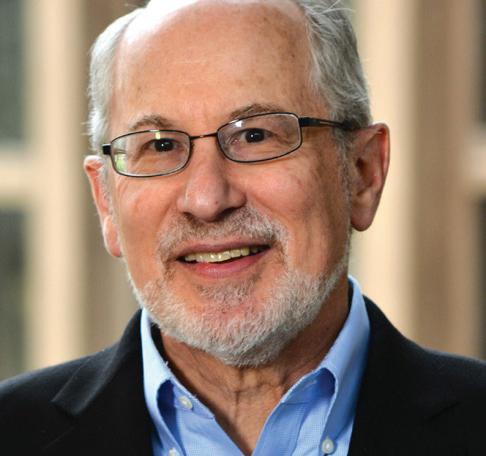
Dr. Insel was affiliated with the University of Rochester Medical Center from 19772003 where he held several positions during his tenure, including Professor of Pediatrics and Microbiology/ Immunology, founding Director of the Center for Human Genetics and Molecular Pediatric Disease, Director of the Strong Children’s Research Center, and Chief of the Division of Pediatric Immunology, Allergy, and Rheumatology. Dr. Insel received pediatric and immunology training at Boston Children’s Hospital, Harvard Medical School, St. Mary’s Medical College in London, England, and the Center for Disease Control.
A major challenge for many clinical diagnostic applications is the quantification of lowabundance proteins in blood. Traditional techniques can only measure several hundred proteins in human blood, which is limiting because there are thousands of proteins present at low concentrations that
David Walt pioneered the use of microwell arrays for single-molecule detection and genetic measurements, which has revolutionized the process of genetic and proteomic analysis, enabling the cost of DNA sequencing and genotyping to plummet nearly a millionfold in the last decade. This technology is now the gold standard for genomic analysis for a wide variety of applications including screening embryos for genetic defects before in vitro fertilization, studying disease in preserved/frozen tissues, improving crop disease resistance, and identifying individuals’ metabolic profiles to ensure proper drug dosage. His lab is developing new diagnostics tools and new biomarker assay technologies based on single molecule detection that can address unmet clinical needs in diagnostics. The lab is focused on early detection of breast cancer, detection of active tuberculosis and other infectious diseases, diagnosis of neurodegenerative diseases, and prediction of immunotherapy response for cancer. His lab has been deeply involved in developing new tools to understand and diagnose COVID-19. Walt’s lab is also pursuing fundamental research on single enzyme molecules to provide insight into enzyme mechanisms. He also is a founder and lead of the Wyss Diagnostic Accelerator (Wyss DxA), which works toward the fast creation of diagnostic technologies to solve high-value clinical problems through deep collaborations between bioengineers, clinicians and industry participants.
David R. Walt is a Core Faculty Member of the Wyss Institute at Harvard University, is the Hansjörg Wyss Professor of Bioinspired Engineering at Harvard Medical School and Professor of Pathology at
are of potential diagnostic utility. We have pioneered the development of technologies that enable 1000-fold increases in sensitivity over conventional protein detection methods. Ultrasensitivity enables smaller sample volumes to be used, which is a significant advantage for pediatric diagnosis.

Harvard Medical School and Brigham and Women’s Hospital, Associate Member at the Broad Institute, and is a Howard Hughes Medical Institute Professor. Walt is co-Director of the Mass General Brigham Center for COVID Innovation. Walt is the Scientific Founder of Illumina Inc., Quanterix Corp., and has co-founded multiple other life sciences startups including Ultivue, Inc., Arbor Biotechnologies, Sherlock Biosciences, Vizgen, Inc., and Torus Biosciences. He has received numerous national and international awards and honors for his fundamental and applied work in the field of optical microwell arrays and single molecules including the 2021 Kabiller Prize in Nanoscience and Nanomedicine, 2017 American Chemical Society Kathryn C. Hach Award for Entrepreneurial Success, the 2016 Ralph Adams Award in Bioanalytical Chemistry, the 2014 American Chemical Society Gustavus John Esselen Award, the 2013 Analytical Chemistry Spectrochemical Analysis Award, the 2013 Pittsburgh Analytical Chemistry Award, and the 2010 ACS National Award for Creative Invention. He is a member of the U.S. National Academy of Engineering, the U.S. National Academy of Medicine, a Fellow of the American Academy of Arts and Sciences, a Fellow of the American Institute for Medical and Biological Engineering, a Fellow of the American Association for the Advancement of Science, a Fellow of the National Academy of Inventors, and is inducted in the U.S. National Inventors Hall of Fame.
In this session, the complexities and challenges of diagnosing rare diseases are highlighted, with over 7,000 identified, affecting more than 3% of the global population. Less than 10% have FDAapproved treatments, and the average time to diagnosis is over six years, often leading to misdiagnosis and increased economic burden. Early diagnosis is crucial, especially as 70% of rare diseases manifest in childhood. A multidisciplinary approach involving, among others, patient organizations, healthcare providers, regulators, and industry is needed to improve health outcomes and equitable care access for individuals with rare diseases, particularly in marginalized communities.
Head, Marketed Products Medical, Global Medical; Global Portfolio Division, Takeda
Neil leads marketed products medical affairs at Takeda with a focus on the planning of product and service support and launches in the US and internationally. He brings 20+ years of academic and private practice experience as a board certified pulmonary, critical care, and sleep physician in the Unites States and Canada in addition to 15+ years of worldwide pharmaceutical, medical device, and biotechnology industry experience.
Takeda’s efforts, alongside a resilient community, include participation in the Global Commission to end the diagnostic odyssey for children, initiatives like Rare-CAP, and collaborations with non-profit advocacy groups to standardize diagnosis and care, improve genomic sequencing access, and reduce research and access barriers. The role of novel diagnostics, biomarkers, and AI in advancing rare disease management is discussed, along with an opportunity for rethinking orphan disease definitions and regulatory frameworks.
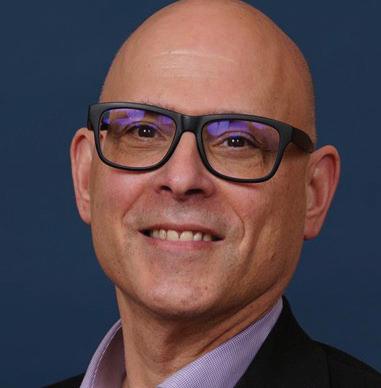
Prior to joining Takeda, Neil served as Chief Medical Officer of Sequana Medical AG based in Zurich. Earlier in his career, he held positions in medical affairs and clinical development at Jazz Pharmaceuticals, Novartis, Baxter, and Boston Scientific. Neil received his BSc in Biomedical Engineering from Rensselaer Polytechnic Institute in Troy, NY, and an MD from McGill University in Montreal.
Suicide is the second leading cause of death for those 10-34 years-old (behind only accidents) and one of the greatest contributors to years of life lost. Two of the greatest, long-standing barriers to suicide prevention are relying on youth themselves to (1) identify themselves as someone who is experiencing suicidal thoughts and (2) monitor and effectively respond to suicidal urges on their own. This talk reports on several recent advances in the use of digital approaches to better detecting, predicting, and preventing of suicidal thoughts and behaviors. First, researchers at Harvard have developed brief (~3 min), reactiontime tests designed to measure the implicit cognitions that people hold about suicidal thoughts and have demonstrated that such
Matthew K. Nock, Ph.D. is the Edgar Pierce Professor of Psychology, Harvard College Professor (2019-2024), and Chair of the Department of Psychology at Harvard University. Professor Nock received his Ph.D. in psychology from Yale University (2003) and completed his clinical internship at Bellevue Hospital and the New York University Child Study Center (2003). Nock’s research is aimed at advancing the understanding why people behave in ways that are harmful to themselves, with an emphasis on suicide and other forms of self-harm. His research is multi-disciplinary in nature and uses a range of methodological approaches (e.g., epidemiologic surveys, laboratory-based experiments, clinic-based studies, digital monitoring via smartphones and biosensors, and web- and social-mediabased experiments) to better understand how these behaviors develop, how to predict them, and how to prevent their occurrence. This work is funded by grants from the US
tests can detect suicidal thinking and predict the occurrence of future suicide attempts in ways that outperform clinician-based predictions. Second, researchers at Harvard have developed smartphone- and wearablesensor-based tools that use digital biomarkers to identify periods or increased risk for suicidal thoughts and have demonstrated that such tools can predict the occurrence of suicide attempts with a higher-degree of accuracy than ever before possible. This presentation will describe these discoveries along with current efforts to further refine them and to develop novel interventions aimed at decreasing the risk of suicidal behavior with the ambitious goal of decreasing the risk of suicidal behavior among youth.
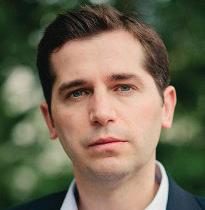
National Institutes of Health, US Department of Defense, US Army, and private foundations and has been published in over 350 scientific papers. Nock’s work has been recognized through the receipt of career awards from the American Psychological Association, the Association for Behavioral and Cognitive Therapies, and the American Association of Suicidology; and in 2011 he received a MacArthur Fellowship (aka “Genius Grant”). At Harvard, Professor Nock has taught courses on statistics, research methods, self-destructive behaviors, developmental psychopathology, and cultural diversity—for which he has received teaching and mentoring awards including the Roslyn Abramson Teaching Award, the Petra Shattuck Prize, and the Lawrence H. Cohen Outstanding Mentor Award.
Syphilis, caused by Treponema pallidum infection, affects millions of people globally every year. Untreated infection leads to numerous, long-term sequela, an increased risk for the acquisition of HIV, substantial losses to quality adjusted life years, and hundreds of millions of dollars in medical costs for individuals and health systems annually. Untreated T. pallidum infection during pregnancy can result in transmission to the fetus, the consequences of which include perinatal death and stillbirth, as well as blindness, deafness, skeletal abnormalities, and developmental delays. Treatment with penicillin during pregnancy prevents more than 98% of cases of congenital syphilis. However, over the last decade, the prevalence of congenital syphilis has increased by more than 1,000% in the United States, and by similar rates in many settings around the world. Individuals who are socially
Dr. Lao-Tzu Allan-Blitz is an instructor of medicine at Harvard Medical School, an associate epidemiologist in the Division of Global Health Equity at Brigham and Women’s Hospital, and a medical epidemiologist at the Massachusetts Department of Public Health. He earned his undergraduate degree in interdisciplinary studies with a colloquium in Happiness from New York University, his medical degree from the David Geffen School of Medicine at UCLA and completed clinical training in both internal medicine and pediatrics through Brigham and Women’s Hospital and Boston Children’s Hospital. Afterwards, he served as the chief resident of the Doris and Howard Hiatt Residency in Global Health Equity, while simultaneously earning a master’s in public health from the T.H. Chan School of Public Health. He subsequently completed his postdoctoral work in translational
vulnerable, impoverished, or marginalized are disproportionately affected, which has further disproportionate repercussions within their communities. In the United States there is no FDA-approved diagnostic test for congenital syphilis. Instead, a diagnosis of congenital syphilis is made based on a history of inadequate treatment in the mother or the presence of consistent symptoms in the neonate. Consequently, many infants may be treated unnecessarily, which requires hospitalization and intravenous penicillin for 10 days. Hospitalization during a critical period of bonding and development can have numerous detrimental effects in addition to exorbitant costs. Therefore, novel diagnostic strategies are urgently needed to address the rise of a highly morbid disease affecting mothers and their unborn children and impacting communities for generations to come.
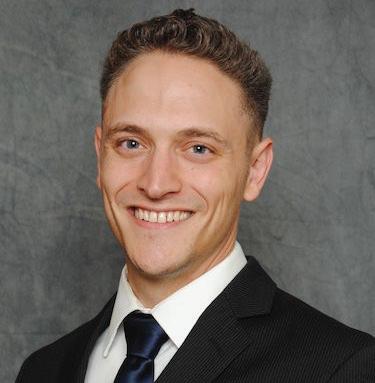
microbiology, developing and implementing novel, low-cost diagnostic assays for sexually transmitted infections and drug resistance. His work led to the development and deployment of a CRISPR-based lateral flow assay for detecting both N. gonorrhoeae and genetic markers of ciprofloxacin resistance. Dr. Allan-Blitz’s laboratory aims to address disparities in sexual health equity through a multidisciplinary combination of epidemiology, public health and community-based program implementation, genomics, and novel technology development. He has conducted work across Peru, South Africa, Botswana, Malawi, Mexico, Sierra Leone, Liberia, Rwanda, Lesotho, Madagascar, China, Vietnam, and rural Australia.
In 2024, CARB-X held a funding call to support the development of approaches enabling the rapid detection of neonatal sepsis. Consistent with CARB-X’s “Aligned by Design” strategy, the organization sought proposals from diagnostic programs to support the growing portfolio of potential maternal vaccines to prevent neonatal sepsis. Products focused on rapid triage, bacterial identification and/or
Betsy Wonderly Trainor is the Diagnostics Alliance Director at CARB-X, a global nonprofit partnership accelerating antibacterial products, including therapeutics, preventatives, and diagnostics, to address drug-resistant bacteria, a leading cause of death around the world. To date, CARB-X has funded over twenty diagnostic programs focused on bacterial infections, two of which have achieved regulatory approval and market entry. Throughout her career, Betsy has focused on the development and commercialization of In-Vitro Diagnostics for viral and bacterial detection, globally. Prior to managing the CARB-X diagnostic portfolio, Betsy led the clinical studies for multiple IVDs throughout Africa and the commercialization of a variety of IVD product lines, globally. She forged strategic partnerships on behalf of both private and public entities. She has supported the development of target product profiles and global guidelines and negotiated deals with large donor organizations and industry. She has supported development efforts at multiple innovative companies, including Daktari Diagnostics, Aldatu Biosciences, SystemOne, and Dimagi, in addition to leading product validation and implementation efforts at the Foundation for Innovative New
antibiotic susceptibility testing were sought. Time-to-result and cost-of-goods were key criteria, and small-sample volumes were critical for this patient population. During this session, an overview of the publicly announced programs that are moving forward will be discussed, as well as some of the other innovation in the pipeline.
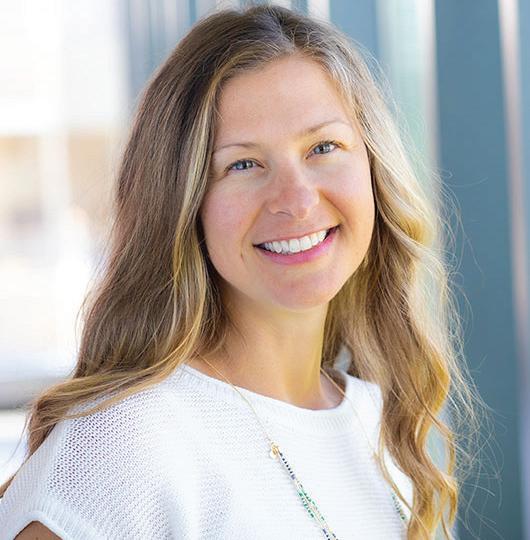
Diagnostics (FIND) and the World Health Organization (WHO). With a range of experience in the areas of pandemic response, diagnostic development, and data management, her research and commentary have been published in academic journals, including BMJ Global Health, Journal of Clinical Microbiology, The Lancet, and PLoS One. Betsy currently serves on the Advisory Panel for the Right Foundation, the India Health Fund, and Pathways to Antimicrobial Clinical Effecacy (PACE). Betsy previously served on the Advisory Panel for the Longitude Prize focused on AMR, the ValueDx Consortium and she co-chaired the National Academy of Sciences Workshop — Accelerating the Development and Uptake of Rapid Diagnostics to Address Antibiotic Resistance. She is deeply interested in policy changes that may enable a healthier market for bacterial diagnostics. Betsy has an interdisciplinary background in behavioral and clinical research and business. She holds a BS in Human Development form Cornell University and has completed executive education training at the University of California, Berkeley, Haas School of Business.
The top 4 conditions that affect children’s health globally, in terms of combined morbidity and mortality, are all infectious diseases. They are, in order: pneumonia, diarrheal disease, malaria, and measles. Although the most lethal illness group overall in children is categorized as “neonatal conditions”, this also includes infections like neonatal sepsis, pneumonia and tetanus. In addition, there is significant burden of disease from tuberculosis and HIV in pediatrics, while malnutrition often results from undiagnosed and untreated intestinal infections.
Although many of our current technologies can be used for diagnosing infections in pediatrics (e.g. culture, PCR, antigen detection, serology), the optimal infectious disease diagnostics for children must take into account the uniqueness and particularities of this population, namely: (1) A distribution of infectious pathogens in some conditions which can be significantly different from adults (i.e. Listeria sp. in neonatal sepsis), (2) The difficulty or inability to obtain “usual” specimens from children (i.e. sputum), (3) The inability to
Independent Physician Consultant (Infectious Diseases, Diagnostics)
Former Executive VP and Chief Medical Officer at bioMérieux, France
Former Full Professor of Medicine at McGill University, Montreal, Canada
Dr. Mark Miller, originally from Montreal (Canada), has had a unique 40-year career consisting of a combination of high-level clinical, academic, and industrial experiences. He is a physician with certification in Internal Medicine, Infectious Diseases, Microbiology and holds a MSc in Epidemiology & Biostatistics.
During his academic 27-year career, he was the Director of 4 university-affiliated hospital departments (Infectious Diseases, Microbiology, ID/ Micro Research, and Infection Control) while being a full-time clinician and researcher. He is a primary or co-author of >150 publications and was the
obtain a relevant history of symptoms, leading to a dependence on tests, (4) Much smaller quantities of specimens available for testing (i.e. blood sampling for sepsis), (5) The non-specific manner in which childhood infections manifest (fever, irritability, lethargy) (6) The need for more rapid diagnostics in the face of swiftly advancing disease because of the presence of an immature immune system, (7) Some infectious diseases are more dangerous in children than in adults (i.e. Dengue) which requires more intensive monitoring tools and prognostic biomarkers.
These unmet and poorly-met diagnostic needs are much more acute and necessary in low- and middleincome countries, where the burden of pediatric infectious diseases (and bacterial resistance as well) is much higher. This makes the development of diagnostic tests even more challenging, considering the necessity for inexpensive and robust equipment, a low cost of goods, ease of use, near-patient testing due to remote populations, and supply chain stability. A series of real cases and situations will be used to highlight the above issues.
co-discoverer of the hypervirulent C. difficile NAP1/027 in 2005. He was granted full Professorship of Medicine at McGill University in 2011.
For 12 years, from 20122024, he was Executive VP and Chief Medical Officer at bioMérieux, a world-wide diagnostics company, where he directed Medical Affairs, Public & Government Affairs, Patient Strategy, and Companion Diagnostics from the head office in France with extensive global travel.
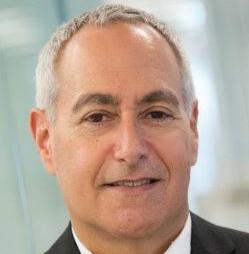
Semi-retired since Jan-2024, he is on the Scientific Advisory Board or an independent physician consultant for several companies and research groups working on antimicrobials, vaccines, and infectious disease diagnostics. He lives in Montreal (Canada), loves skiing, swimming and pickleball, and has 2 children and 3 grandchildren.
Sepsis, a life-threatening systemic response to infection, remains one of the most critical and frequent diagnostic challenges in neonatal care. In the U.S. alone, there are an estimated 1.75 million suspected cases of neonatal sepsis each year. The most common diagnostic test in neonatal intensive care units is the “rule-out sepsis” screen. It is typically performed via painful heel sticks to obtain blood for culture or molecular testing. These methods are imprecise and slow, leading to widespread empirical administration of antibiotics. However, unnecessary antibiotic exposure in neonates is associated with severe risks, including altered neurodevelopment, microbiome disruption, and increased incidence of Necrotizing Enterocolitis.
Louise L. Hansen, PhD, is a postdoctoral fellow at the Wyss Institute for Biologically Inspired Engineering at Harvard University and Brigham and Women’s Hospital, where she works in the laboratory of Dr. David Walt. Her current research focuses on the development of novel bead-based ELISA technologies for the ultrasensitive detection of infectious disease biomarkers. Across her academic training in bioengineering, analytical chemistry, and assay development, Louise’s work centers on inventing accessible technologies that enable precise protein measurements using widely available laboratory tools. She earned her PhD in the UC Berkeley–UCSF Graduate Program in Bioengineering, where she led the development of an electrophoretic separation method for quantifying cytoskeletal
To address these shortcomings, we conducted the largest salivary proteomic study to date in neonates, enabled by ultrasensitive beadbased ELISA technology that allows for detection of low-abundance proteins in saliva. We identified a panel of 12 infant-derived biomarkers and combined these with clinical metadata from medical records to build a predictive diagnostic model using machine learning. This integrated, non-invasive, painfree assay achieves ~80% accuracy. This platform has the potential to dramatically reduce unnecessary antibiotic exposure in vulnerable newborns. Ongoing work focuses on translating this technology into clinical practice and exploring point-of-care implementation strategies.
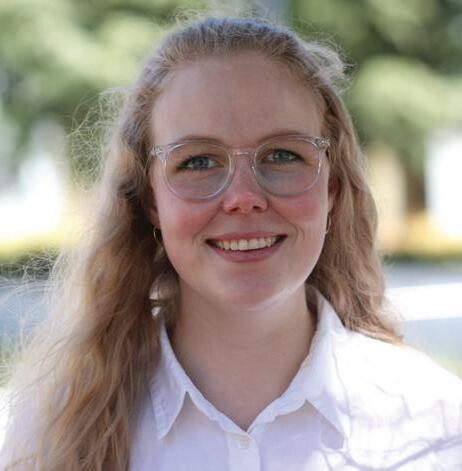
protein complexes from single cells. During her doctoral training, she also interned with GH Labs, an initiative of the Bill & Melinda Gates Foundation, where she contributed to the development of point-of-care diagnostics. Louise’s broader research interests lie at the intersection of bioengineering and global health, with a particular focus on designing affinity-based, ultrasensitive protein assays for diverse sample types. Her long-term goal is to develop technologies that both empower other scientists and expand access to advanced diagnostic tools in clinical and resourcelimited settings.
Genetic disorders are a leading cause of childhood morbidity and mortality worldwide— yet over 94% of children born with genetic conditions live in low- and middle-income countries where access to diagnostics remains scarce. In this talk, Mr. Tan Rasab presents a transformative vision for democratizing access to pediatric genetic testing through SiGenex’s point-of-care sequencing platform.
He explores the global burden of pediatric genetic disorders, highlights systemic barriers such as infrastructure, cost, and diagnostic delays, and introduces SiGenex’s novel digital microfluidics technology. This compact, AI-powered “lab-in-a-box” enables rapid, affordable, and fully automated genetic testing directly in hospitals and clinics, even in resource-limited settings.
Tan Rasab is the CEO & Founder of SiGenex, a startup health technology company that is leveraging Artificial Intelligence, low-cost digital thin film transistor based microfluidics, computer vision and NGS in an integrated sample to report benchtop platform to enable clinical NGS based genetic testing for therapy decision making for everyone everywhere.
Through real-world use cases—including newborn screening, pediatric oncology, rare disease diagnostics, and infectious disease detection—Mr. Rasab illustrates how SiGenex is shortening diagnostic timelines from weeks to hours, improving therapy outcomes, and scaling globally via a zero-capital-expenditure deployment model.
The presentation concludes with a powerful call to action: to join a global movement to bring equitable, life-saving genomic diagnostics to all children—regardless of where they are born. Attendees are invited to collaborate, fund, and deploy these technologies to help bridge one of the most urgent gaps in global child health.
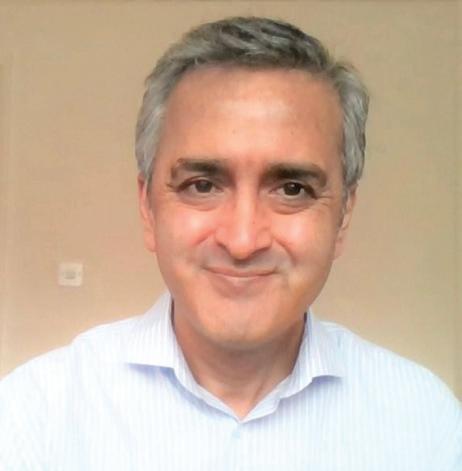
Tan has founded 2 startups over the last 25 years while also working with other startups, multinationals and public sector organizations in strategy consulting, technology, health, energy and in three continents.
Tuberculosis (TB) is one of the leading causes of death worldwide. In 2023, there were an estimated 1.3 million cases among children and young adolescents (aged 0–14 years) with 191,000 deaths, ~15% of the estimated total number. TB disease is curable using antibiotics, but most people who die of TB never begin treatment because they are not diagnosed, as TB diagnostic tests are inaccessible and not sensitive enough, especially for diagnosing children. TB diagnostic tests rely on biohazardous sputum (culture, smear microscopy), which is extremely hard to obtain from children, in addition to being biohazardous for the healthcare workers. The gold standard culture test is slow, and clinical diagnosis is nonspecific. Previously, we developed and validated an ultrasensitive Single Molecule Array (Simoa) assay to detect TB in adults’ urine by measuring the concentrations of two TB biomarkers: lipoarabinomannan (LAM) and antigen 85B (Ag85B). Our assay classifies samples as TB positive or negative with 98% specificity. However, its sensitivity of 45% shows that there is a substantial number of
Dr. Shira Roth is an expert in developing beadbased assays, biosensors, and diagnostic tools. She holds a B.Sc. and M.Sc. in biotechnology engineering from Ben-Gurion University, Israel, and a Ph.D. in bioengineering from Bar-Ilan University, Israel. Her Ph.D. research in the optical imaging and biosensing laboratory focused on developing methods to identify protein interactions using a magnetic modulation biosensing system.
false negatives, partially because in many people with TB, LAM is below the detection limit of an ultrasensitive assay. We observed an even more pronounced gap in sensitivity with Simoa for many other Mycobacterium tuberculosis (M. tb) antigens in urine, with <50% detectability in our initial discovery cohort. Since the levels of M. tb biomarkers in children are expected to be lower than for adults, increased sensitivity is needed. In this study, we utilize Molecular On-bead Signal Amplification for Individual Counting (MOSAIC) technology that was shown to have one to two orders-of-magnitude increased sensitivity, to detect M. tb biomarkers in pediatric urine. The expanded multiplexing capabilities of MOSAIC can further improve clinical sensitivity and specificity by including additional M. tb antigen biomarkers while minimizing costs. Using safe-to-use and easily obtained urine samples and MOSAIC readout with a flow cytometer can enhance the test’s accessibility for children. We expect to be able to detect more M. tb biomarkers in pediatric urine and thereby develop a more accurate, accessible pediatric TB diagnostic test.
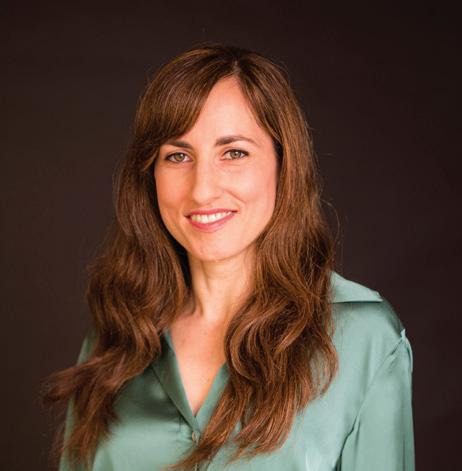
Currently, Dr. Roth is a postdoctoral fellow at the Wyss Institute for Biologically Inspired Engineering at Harvard University in the laboratory of Prof. David R. Walt for advanced diagnostics. She is developing tools for clinical diagnostics and single-molecule assays for unmet clinical needs, such as identifying tuberculosis in urine.
Extracellular vesicles (EVs) are membranebound packages of RNA and protein released into biofluids such as plasma, and hold great potential as a new class of biomarkers for pediatric health. However, the utility of analyzing EVs in clinical samples has been hampered by a lack of suitable EV isolation methods that can be performed reproducibly in a scalable manner. The current method of choice for isolating EVs, size exclusion chromatography (SEC), is performed manually one column at a time, and thus does not have the throughput for isolating EVs from clinical samples. We have adapted SEC to a plate-based format to increase its throughput together with liquid handling platforms that
we use with custom-built adapters. We are combining this EV isolation platform with downstream omics platforms such as mass spectrometry-based proteomics. Isolating EVs allows for deeper coverage of the plasma proteome due to the removal of soluble proteins such as albumin. Our work represents a solution to the long-standing challenge in the EV biomarker field of reproducible highthroughput EV isolation from plasma and other biofluids. We envision that the automated methods we have developed will scale SEC to hundreds of samples per day, enabling the use of EVs for biomarker discovery and novel diagnostics in pediatric health.
Dima is a Senior Scientist at the Wyss Institute working closely with the Wyss Diagnostics Accelerator and the Synthetic Biology Platform. His research primarily focuses on the biology and applications of extracellular vesicles. He was previously a postdoctoral fellow and, before that, graduate student coadvised by George Church at Harvard Medical School and Aviv Regev at the Broad Institute. Before graduate school, Dima performed research at the Curie Institute in Paris and
was an early employee at Exosome Diagnostics, a company developing novel liquid biopsy technologies for cancer. He has also consulted for companies and investors in the life science industry. He received a Ph.D. in biochemistry from Harvard University, where he was a recipient of the James Mills Pierce Fellowship, and a BS in biology from MIT.
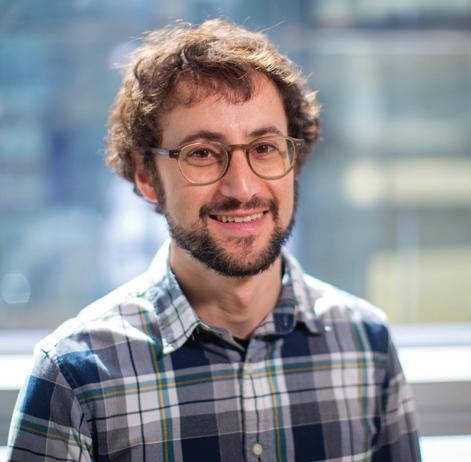
The Wyss Institute and the Diagnostics Accelerator (DxA) has established a state-of-the-art Biomarker Discovery Laboratory (BDL) to support the development of innovative, high-impact diagnostics for diseases with urgent clinical needs. At the core of the BDL is a robust proteomics platform that integrates automated sample processing, high-resolution mass spectrometry, and advanced computational pipelines. This platform is optimized for analyzing clinically relevant biospecimens—often limited in volume or quality—such as blood, stool, urine, and saliva. With deep proteome coverage routinely exceeding 1,500 proteins per sample, including both human and microbial signatures, the BDL is uniquely positioned to drive biomarker discovery in realworld clinical contexts.
In this presentation, we demonstrate the application of this platform to necrotizing enterocolitis (NEC), a devastating and unpredictable gastrointestinal disease that affects premature infants in neonatal intensive care units. NEC is notoriously difficult to diagnose early and carries a mortality rate of up to 50% in severe
Bogdan Budnik obtained his undergraduate degree in General Physics in 1997 and a Master’s Degree in Nuclear and Plasma Physics in 1999 in Kharkiv State University, Ukraine. In 2002 he defended his PhD thesis on utilizing ion-electron reactions to study biomolecules in Fourier transform mass spectrometry. After completing his PhD, Bogdan joined the Mass Spectrometry Center at Boston University Medical Center as postdoc and worked on glycosylated peptide analysis. In 2004, he joined Harvard Medical School as an Instructor in the newly established Proteomics Center at Boston Children’s Hospital. Having spent two years analyzing myriad proteomics samples with the FTICR instrument, Bogdan moved to Harvard University’s proteomics group in 2006. He has worked at the Harvard University
cases. Our study leveraged longitudinal stool samples collected from matched NEC and control infants prior to and after clinical onset. Through deep fecal proteomics, we identified reproducible and disease-relevant signatures that distinguished infants who would go on to develop NEC. These signatures included early downregulation of brush border structural proteins, immunoglobulin chains, and mucosal defense proteins, as well as upregulation of oxidative stress and injury markers. Intriguingly, several bacterial proteins were also differentially regulated, pointing to a role for gut dysbiosis and host-microbe interactions in NEC pathogenesis.
This talk will highlight how the DxA BDL enables end-to-end biomarker discovery—from sample prep to candidate prioritization—and how our NEC study exemplifies its capacity to generate clinically translatable insights. By identifying a panel of NECassociated biomarkers with potential for bloodbased detection, this work represents an important step toward developing a rapid diagnostic tool that could transform neonatal care.

Mass Spectrometry and Proteomics Resource Laboratory for 15 years, where he was a scientific manager and director of proteomics. Bogdan joined the Wyss Institute at Harvard University in February of 2022 as a Principal Scientist, where he leads the Biomarker and Drug Discovery Laboratory. Bogdan’s research interests include multiomics analysis of single cells, biomarkers based on exosome analysis, and liquid biopsy samples, as well as cell specific proteome analysis of brain tissues. Bogdan serves on the Biology of Disease committee at the Human Proteome organization and the Single Cell Initiative at HUPO.
Innovation in pediatric rare disease research is in grave trouble. Fiscal support for research from government and private investment is rapidly shrinking. The gene therapy pipeline has slowed, especially for rare diseases that often present first in young children. Start-ups are overburdened by regulatory requirements and recruitment challenges even though parents of kids with rare diseases may be less risk-averse than participants in other domains of clinical research. Too often, this results in delayed or unavailable treatment during a child’s early developmental years, when it could be most effective.
Following 1960’s – 1980’s scandals at Tuskegee and other institutions, regulations in the USA became front-loaded and “protectionist,” seeking to prevent harm to the youngest clinical research participants by setting tight guardrails around consent, IRB committee review and conflict of interest management to help ensure safety and guard against misuse or exploitation by researchers. But the environment has shifted. To speed pediatric rare disease research from a regulatory perspective while balancing ethical concerns, several changes should be considered including: •using new endpoints to demonstrate efficacy; •shortening phase 1 and 2 trials in favor of merged trials; •more coordinated and/or platform trials to manage the challenge of low numbers of rare-disease patients; •willingness to
Arthur Leonard Caplan is currently the Drs. William F and Virginia Connolly Mitty Professor and founding head of the Division of Medical Ethics at NYU Grossman School of Medicine.
Dr. Caplan is the author or editor of thirty-five books and over 880 papers in peer reviewed journals. He has served on a number of national and international committees including as the chair of
the National Cancer Institute Biobanking Ethics Working Group, chair of the Advisory Committee to the United Nations on Human Cloning; chair of the Advisory Committee to the Department of Health and Human Services on Blood Safety and Availability. He has also served on the Presidential Advisory Committee on Gulf War Illnesses, the special advisory committee to the International Olympic Committee on genetics and gene therapy, the Special Advisory Panel to the National Institutes of Mental Health on Human Experimentation
conduct pivotal trials and even proceed to approval with less data, allowing more risk when participants/ families consent; •accept more risk of side effects or early death, balanced with requirement for mandatory tracking and post-approval surveillance; •create insurance pools for high-risk studies rather than forcing participants to chase their own insurance; •shift more funding to private philanthropy if participants are unable to pay; •build better trust among participants by developing a model that does not prioritize protection of intellectual property; •enable more participant/ family advocate voices on Institutional Review Boards and Data Safety Management Boards; •mandatory updates on participant status and 30-day updates to all participants/families after post research phases end, to reward participation and fulfill duty to participants; •mandate transparency in payer funding decisions on eligibility for pediatric rare disease therapies.
Families facing rare diseases trust their providers and researchers and are ready to accept more risk in this space. Moving away from third party protectionist ethics at the start of research to greater involvement of families and competent subjects in oversight plus more mandatory participation in follow-up and registries post-approval gives a path to accelerate pediatric rare disease research, monitor safety and perhaps attract more financial investment.
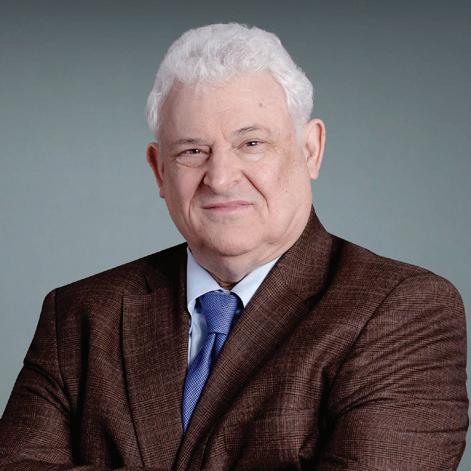
on Vulnerable Subjects, the Wellcome Trust Advisory Panel on Research in Humanitarian Crises, and the co-director of the Joint Council of Europe/ United Nations Study on Trafficking in Organs and Body Parts. He is currently a member of the National Academy of Science and Medicine’s expert advisory committee on hand and face transplantation and the lead ethics advisor to the Hevolution Foundation.
Caplan has served since 2015 as the co-chairperson of the Compassionate Use Advisory Committee (CompAC), an independent group of internationally recognized medical experts, bioethicists and patient representatives which advises Johnson & Johnson’s Janssen Pharmaceuticals about requests for compassionate use of its investigational medicines.
Rare diseases affect 1 in 10 Americans—and half of those impacted are children. Yet over 95% of these conditions still lack an FDAapproved treatment. This session explores the scientific, economic, and policy-driven realities of bringing life-changing therapies to the children who need them the most. Through a patient-centered lens, we’ll examine the scientific hurdles of rare disease
Dr. Matthew Winton is Chief Operating Officer at Inozyme Pharma, a clinical-stage biotech company advancing transformative therapies for rare diseases of abnormal mineralization. With a career spanning two decades in the biotechnology and pharmaceutical industries, he brings deep expertise in drug development, commercialization, and patient access.
Prior to Inozyme, Dr. Winton held key leadership roles at Biogen, including Senior Vice President of the U.S. Multiple Sclerosis franchise and Head of the Spinal Muscular Atrophy (SMA) franchise, where he oversaw the launch and management of several key therapeutic programs. He also served as
drug development, the ethical dilemmas of affordability and clinical trial design, and the constant challenges faced by families navigating care. With public policy playing a pivotal role, this session offers a grounded, real-world look at how collaboration across sectors can break barriers and bring hope to those who’ve waited too long.
Director of Payer and Channel Marketing and Chief of Staff to the CEO, bridging science, strategy, and public policy to expand access to innovative treatments.

Dr. Winton began his career in management consulting, advising clients from startups to global pharmaceutical companies. Dr. Winton holds a Ph.D. in Neuroscience from the University of Montreal, an MBA in Healthcare Management from Boston University, and a B.Sc. from York University.
The beauty of biotechnology is that it is atomically precise and infinitely scalable. Human society has harnessed this power of biotech to engineer innumerous diagnostics, therapeutics, and prophylactics to fight communicable and non-communicable illnesses. Even though there is consensus in the scientific community that a greatest causal factor of diseases is environmental exposures, there are few clinical diagnostics tests for environmental pollutants and only a handful of efficacious treatments to thwart harms. Therefore, Homeworld’s Pollution Program is laser-focused on how to reposition small molecule pollution in order to make it more accessible by the larger biotech community.
We start by centering our attention on one of the most damaging and potent toxins in the world – elemental lead (Pb2+). Globally, lead exposure is estimated to contribute to 5 million deaths per year and $6 trillion dollars
Daniel Goodwin is the co-founder and Executive Director of Homeworld Collective, a nonprofit dedicated to advancing climate biotechnology by building a strong community, fostering knowledge, and securing funding for innovative solutions. He holds a PhD from MIT, where his research focused on developing advanced tools for
in global health burdens. Lead exposure is expected to lower the average IQ by 6 points amongst the 800 million children who are affected worldwide. The gold standard method for testing for lead exposure is expensive and inconvenient in most settings, while the point-of-care tests can be unreliable and lack sensitivity. To spur the bioengineering community into action, we have worked with experts on creating clear specifications for new lead tests. Specifically, we consider alternative biomarkers as potential proxies of lead exposure that balance accuracy and economics. Given the strong and urgent need for immediate improvements in testing, therapies, and preventive medicine, lead can act as an entry point for classic biotech to engage the environmental health field. In the best case, new solutions to childhood lead poisoning could later be adapted to tackle the myriad other small molecule challenges.
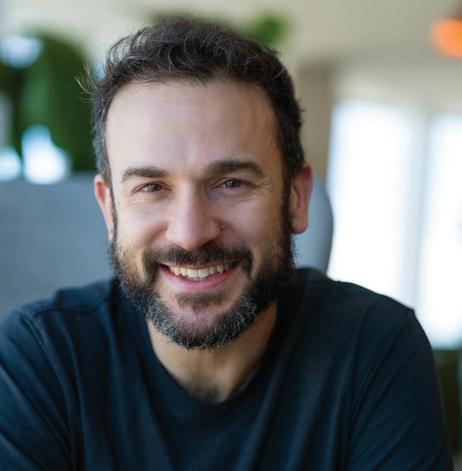
neuroscience under the mentorship of Ed Boyden. Prior to his work in climate and biotechnology, Dan co-founded Mobile Data Labs, creators of the widely-used MileIQ app, which was later acquired by Microsoft.
Fetal Alcohol Spectrum Disorders (FASD) are among the most prevalent—but chronically under-recognized—neurodevelopmental conditions, affecting an estimated 1 in 20 U.S. school-aged children. Despite more than 50 years of research, FASD remains a hidden epidemic, often misdiagnosed or entirely overlooked by medical professionals.
In this presentation, Constance Mazelsky, cofounder of FASD Maine and board member of FASD United, draws on both personal experience and national advocacy to expose the systemic gaps in diagnosis, care, and public understanding of FASD.
With no single standard diagnostic test, and with facial features present in only a minority of cases — early identification remains a major challenge. Based on her family’s experience and years of learning from researchers and
Constance Mazelsky is a dedicated advocate for individuals affected by Fetal Alcohol Spectrum Disorders (FASD). In 2019, she co-founded FASD Maine, a grassroots organization committed to increasing awareness and prevention of FASD through education and support for families, clinicians, educators, and community stakeholders. Her passion for this cause stems from personal experience. After years of seeking an accurate diagnosis for her adopted child, she discovered her child had FASD, motivating her to assist others facing similar challenges. Listen to Constance share her story on Maine Public Radio.
Professionally, Constance has an extensive background in high-tech marketing and
clinicians, Mazelsky highlights the critical need for accurate and rigorous diagnostic tools— particularly in infants and toddlers—before behavioral issues escalate and secondary disabilities emerge.
Through real-world examples and researchinformed insights, Mazelsky makes a compelling case for why FASD deserves more attention within clinical practice, public health policy, and medical education. By recognizing FASD and promoting prevention where possible, we may even start to address some of society’s most intractable problems such as chronic homelessness, failures in our system of education, and recidivism in our juvenile and criminal justice systems.
The message is clear: when we recognize FASD early, we empower individuals and families to succeed.
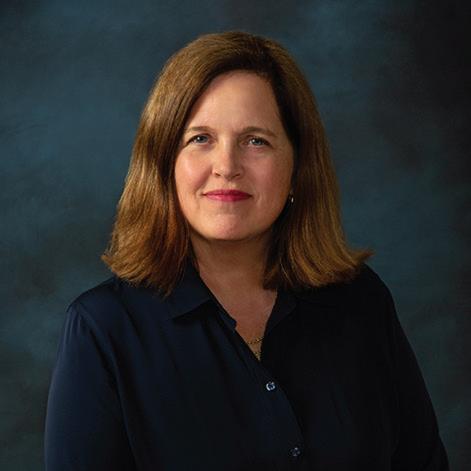
international business, with a focus on media relations. She founded her own communications company and served as Vice President at one of Boston’s leading high-tech public relations agencies. Additionally, she managed marketing communications for HewlettPackard in Europe, overseeing international product launches.
Raised in Alexandria, Virginia, Constance earned her A.B. degree from Bryn Mawr College. She serves on the Board of Directors for FASD United, where she continues her advocacy work to improve systems of care at both federal and state levels.
Despite remarkable advances in science and growing entrepreneurial talent, pediatric innovation continues to face funding challenges — not for lack of opportunity, but because traditional capital flows rarely prioritize children. In this talk, John Parker, Trustee of the Charles H. Hood Foundation and Founder of Springhood Ventures, shares how one organization expanded its funding toolkit — moving from grants to programrelated investments, and ultimately to a venture capital fund focused entirely on child health.
John Parker is the Founder and Managing Partner of Springhood Ventures, an early-stage venture capital firm that invests in life science and healthcare companies transforming the health and care of children. Mr. Parker founded Springhood following his success creating and managing CH Innovations, the impact-first venture capital subsidiary of the Charles H. Hood Foundation, a Boston-based family foundation that supports pediatric research, where he also serves as a trustee.
John is currently a director or observer on the boards of Xploro, Inc, Plakous Therapeutics, Deck Therapeutics, SmolTap, Argus Cognitive, Anida Pharma, Mesentech, Inc., and Prapela, Inc.. He also serves on the advisory boards of multiple nonprofit entities, largely around
This approach offers a real-world example of how philanthropic and return-seeking capital can work in concert to support pediatric innovation across stages of development. Parker does this by seeking out business models intentionally designed to succeed within the unique clinical, regulatory, and market conditions of pediatrics — proving that purpose-built strategies can unlock both meaningful impact and investable opportunity.
mission-driven healthcare investing. He is a frequent speaker on pediatric innovation and mission investing.
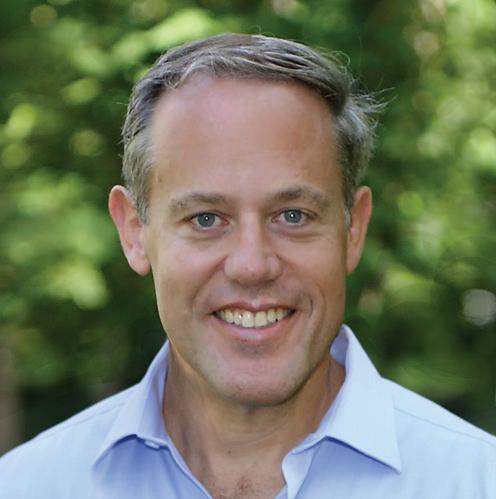
Previously, John spent 25 years in the alternative investment industry, including senior roles in venture capital, private equity, and hedge funds. Early in his career he worked in international merchant banking. Although currently living in the Boston area, John spent portions of his career in New York, Tokyo, and Sydney and has done business in over 20 countries on 6 continents. John has a BA from Dartmouth College and an MBA from Dartmouth’s Tuck School of Business.
Pediatrics research is a subset of overall clinical research and is subject to similar issues regarding data availability and quality. Pediatric clinical trials are much more challenging than clinical trials in adults, because of the complexity involving researching experimental therapies with children, involving their parents, and often imposing difficult adherence requirements on their entire family.
TriNetX is a privately funded organization that is bringing together hospitals, pediatric
Gadi Lachman is the Founder of TriNetX, the world’s broadest federated network of global real-world data and evidence for life sciences and healthcare.
TriNetX partners with leading healthcare organizations around the world to bring together the most comprehensive, privacy compliant real-world data network. It applies advanced analytics and intelligence to help life sciences, researchers, and regulators accelerate breakthroughs in care.
hospitals, pharma research projects and academic researchers – all under the umbrella of high quality, deep and secure data sharing –combined with an advanced analytics platform – enabling a massive amount of research to be conducted and push the insight generation of pediatric disease forward.
The discussion will focus on the “what” (data, analytics, research) and how is it funded with all participants – pharma, hospitals, and patients.
Gadi Lachman previously held leadership positions at TriZetto, American Well and Eliza. He was also at Lehman Brothers and was an Officer in Israeli Special Forces.
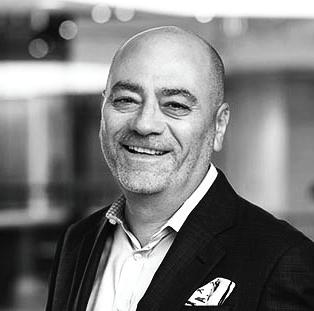
Gadi earned his MBA at the Harvard Business School with high-distinction (Baker Scholar), and his LLB in law and B.C. in accounting from Tel-Aviv University.
Preventing toxic and traumatic stress in children is not only possible—it is essential for effective, long-term health outcomes. In this short presentation, Thomas Hübl will offer a concise introduction to the role of relational safety in pediatric care. Drawing on current research, he will show how Adverse Childhood Experiences (ACEs) can be mitigated through Positive Childhood Experiences (PCEs),
Thomas Hübl, PhD, is a renowned teacher, author, and international facilitator who works within the complexity of systems and cultural change by integrating the core insights of the great wisdom traditions and mysticism with the discoveries of science.
Since 2004, he has taught and facilitated programs with more than 100,000 people worldwide, including online courses, which he began offering in 2013. He is the author of Attuned: Practicing Interdependence to Heal Our Trauma—and Our World (2023) and Healing Collective Trauma: A Process for Integrating Our Intergenerational and Cultural Wounds (2020), which was featured in Oprah Daily as one of “9 Books to Help with Old, Painful Traumas”. He has published articles in Harvard Health and the Journal of AwarenessBased Systems Change.
particularly when caregivers and professionals are equipped with basic self- and coregulation skills. From the parent-child dyad to teacher and medical care units, Hübl will outline how interconnected, trauma-informed relationships form an ecosystem of healing and stress reduction. He will conclude with a vision for embedding these principles into the foundations of healthcare systems.
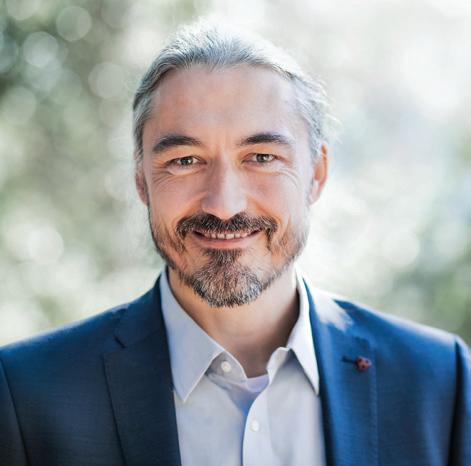
Hübl has served as an advisor and guest faculty for organizations and universities and is currently a visiting scholar at the Wyss Institute at Harvard University. He has presented talks and taught workshops on resilience, collective healing, and relational competencies for healing trauma at Harvard Medical School since 2019.
As an executive coach and trainer, he supports CEOs, consultants, coaches, and leaders in their personal and professional development, guides trauma-informed leadership, and provides senior supervision and guidance.
The broader application of genome sequencing in rare disease patients has led to an increase in the identification of causative genetic mutations. While this has shortened the diagnostic odyssey for many families, research that is needed to understand the pathophysiology of disease and the advancement of therapeutics continues to lag. The incorporation of cell-based models from patient fibroblasts as well as organoids are useful tools in the overall discovery toolbox, but an in vivo mammalian model is often needed to understand the disease at the level of the whole organism. There are multiple advantages to using mouse models
As the Vice President of the Rare Disease Translational Center (RDTC) at The Jackson Laboratory (JAX), Dr Lutz works with patientbased foundations, researchers, and industry partners to roadmap therapeutic strategies for rare diseases. Her work involves the engineering of preclinical mouse and cellbased models that represent patient-based mutations and the subsequent phenotyping
to understand human disease, including a high conservation of gene sequence and protein function. In addition, the mouse genome can easily be manipulated to engineer patient specific mutations onto inbred backgrounds, creating a patient avatar for disease. Over the years, molecular tools, reagents and antibodies have been designed around the mouse, allowing for the advanced interrogation of hypotheses. Importantly, mouse models allow for the testing of both broad based and individualized therapeutics, allowing for the assessment of safety, efficacy, timing of delivery and insights into dosing levels and routes of administration.
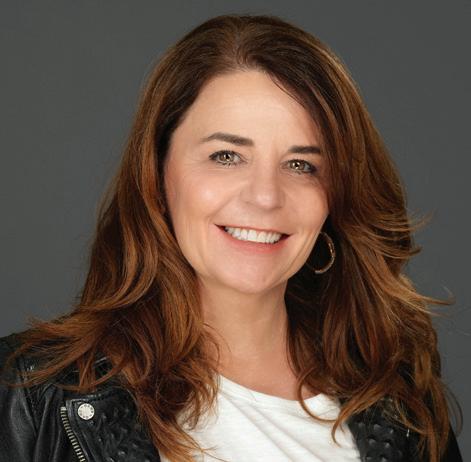
of the mice to test and develop therapeutics for IND enabling studies. She has served numerous patient-based foundations and was the recipient of the 2021 Rare Impact Award by the National Organization for Rare Disorders (NORD).
Drug discovery has failed patients in general and pediatric patients in particular. Most drugs fail during development mostly because they fail to work in actual patients - despite strong preclinical data. Unravel Biosciences is revolutionizing drug development by clinically derisking new targets using existing drugs, starting with personalized discovery in individual patients. By treating patients, not diseases, we build better drugs that work across disorders to make rare and ultra-rare diseases commercially attractive. Our noninvasive gene network analysis allows us to identify molecular signatures of disease within an individual suffering from a disease. Our AIpowered discovery engine uncovers new drug targets for specific patients.
Richard Novak is the founding CEO of Unravel Biosciences, Inc., which he spun out from the Wyss Institute at Harvard University to develop therapeutics for orphan diseases using a novel AI drug prediction and in vivo screening platform. Prior to Unravel Bio, he was a Lead Engineer at the Wyss Institute at Harvard University where he managed the Microengineering Team and led development of human Organ Chips, Organism-on-Chip screening platforms, and analytical and diagnostic instrumentation for accelerating therapeutics discovery and precision diagnostics. Richard received his PhD in Bioengineering from UC Berkeley/UC San Francisco where he developed microfluidic single cell analytical and diagnostic platforms
Our in vivo screening platform allows us to rapidly generate data with which to enter the clinic to clinically validate the novel therapeutic strategy. Put together, we can discover, validate, and clinically de-risk individual disease biology 2-3x faster and >10x cheaper than competing approaches. Unravel’s platform has led to two clinical trials starting in 2025. Unravel’s platform developed RVL002, a first-in-class new small molecule targeting mitochondrial metabolism, and RVL027 and RVL068, molecules targeting two novel mechanisms to treat dystonias. The rareSHIFT™ program provides platform access to foundation and biotech partners to accelerate and clinically derisk therapeutics.

for forensic, therapeutic, and basic research applications. He is the founder of Future Scientist, a nonprofit that works with resource-poor communities to design sustainable solutions through their prototyping and development hub in Panama. Richard also is a founder of Rhinostics Inc., a medical consumables company that has developed an automatable sample collection platform that accelerates and expands access to respiratory, blood, and genomic laboratory testing through integration with existing lab automation instruments. He is a Termeer Fellow and former DARPA Riser.
Food allergy (FA) has reached epidemic proportions in developed countries, affecting around 8% of children and 11% of adults in the US. It can lead to life-threatening allergic reactions, provoke chronic anxiety and lead to social isolation, thus significantly affecting the quality-of-life of FA patients and their families. For most food allergies, the standard of care primarily consists of avoidance of the offending food allergen and keeping rescue medicine (adrenaline) available for emergency use. While new therapies such as peanut oral immunotherapy (OIT) and omalizumab (anti-IgE antibody) have recently been approved by the FDA, they are not known to be curative as cessation is associated with disease relapse in most patients. Additionally, the treatment is hampered by allergic reactions to OIT, taste aversion and compliance difficulties. There is an unmet need for novel therapies that can either be disease modifying or curative. Therapies currently under investigation include bruton’s tyrosine kinase (btk) inhibitors, peanut peptides, peanut IgG4 monoclonal antibodies and microbiome therapies. We evaluated in a phase I trial the safety and efficacy of oral encapsulated fecal microbiome transplantation (FMT) in peanut-allergic adults.
Dr. Rachid is the Director of Allergen Immunotherapy and the co-Director of the Food Allergy Program at Boston Children’s Hospital (BCH) and an Associate Professor of Pediatrics at Harvard Medical School. She is the Principal Investigator of the National Institute of Health (NIH) sponsored Consortium of Food Allergy Research (CoFAR) center at BCH and the Principal investigator of the Food Allergy Research and Education (FARE) Discovery center at BCH. She leads multiple ground-breaking clinical and translational research studies evaluating novel therapies for food allergy. She also serves as the Chair of the Food Allergy and Eosinophilic disorders Interest Section at the American Academy of Allergy, Asthma and Immunology.
Dr. Rachid is a pioneer in evaluating microbiome interventions in food allergy. Her studies played a pivotal role in uncovered ongoing dysbiosis in children with food allergies. She is particularly
An increase in the peanut dose threshold of reactivity from traces prior to FMT to up to 3 peanuts post FMT was noted in a subset of patients. In these responders, FMT increased tolerogenic RORgt+ regulatory T (Treg) cells and decreased T helper 2 (Th2) cells. Food Allergy prone mice transplanted with the microbiome of post-FMT responders were protected from FA in association with increased RORgt+ Treg cell frequencies and increased colonization with members of the gut Bacteroides, unlike mice transplanted with non-responders’ stools or baseline responders’ stools. In both human and mice, protection by FMT was associated with increased bile acid metabolites. Deletion of a bile salt hydrolase in a candidate protective Bacteroides abrogated FA suppression in mice. We are currently conducting a phase II randomized placebo-controlled trial in teens with peanut allergy to evaluate the safety and efficacy of microbiota transplantation therapy (MTT), which is a purified form of FMT containing <1% fecal material. These cutting-edge study will provide the impetus for larger studies evaluating the microbiome in food allergy, and ultimately the development of second-generation human probiotic or metabolomic therapies.
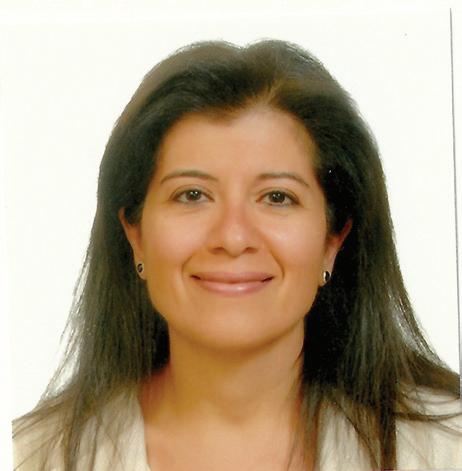
interested in developing precision medicine, by exploring patient-specific microbial signatures influenced by geographical, cultural, dietary, and genetic factors. She is leading the first trials in the world to evaluate the role of Fecal Microbiota Transplantation in peanut allergy. These ground-breaking microbiome studies will provide the impetus for the development of second-generation precision based probiotic therapies.
Her work was published in cutting-edge journals including Nature Medicine, Nature, the NEJM, Immunity and JACI and was covered by media outlets including Reuter Health, Scientific American and the New York Times. Dr. Rachid is a co-inventor on four patents targeting the treatment and prevention of food allergy.
This research explores the development of fusion-specific T cell therapies for pediatric cancers driven by fusion proteins, a class of genetic rearrangements that produce tumorspecific neo-antigens. These fusion proteins, unique to cancer cells, present an ideal target for immunotherapy. The study focuses on overcoming challenges in identifying tumor-specific peptides and expanding rare, exhausted T cell populations. To address these obstacles, the research employs a novel 3D system mimicking antigen-presenting cells (APC-ms), which enhances the expansion of fusion-specific T cells with high precision. This system enables the identification and
Dr. Yoav Binenbaum is a physician-scientist at Dana-Farber/Boston Children’s Cancer and Blood Disorders Center and an Instructor in Pediatrics at Harvard Medical School. Trained as both a pediatric oncologist and cancer immunologist, Dr. Binenbaum earned his MD from Tel Aviv University and a PhD in Cancer Immunology from the Technion Institute of Technology. His doctoral work uncovered mechanisms by which macrophage-derived exosomes drive chemotherapy resistance in pancreatic cancer—an early demonstration of his commitment to translating immune biology into therapeutic innovation.
Currently, Dr. Binenbaum’s research bridges clinical pediatric oncology with bioengineering at Harvard’s Wyss Institute.
enrichment of T cells targeting fusion neoantigens for adoptive T cell therapy. The approach is exemplified in a proof-of-concept study with Ewing sarcoma (ES), where fusionspecific T cells targeting the EWS-FLI1 fusion protein demonstrated specific cytotoxicity against tumor cells in vitro. The next steps involve evaluating T cell efficacy in vivo and expanding the approach to other pediatric cancers, such as ependymomas. This research aims to establish a platform for personalized immune therapies to treat a wide range of fusion-driven pediatric cancers, addressing the gap in innovative treatments for these underrepresented diseases.
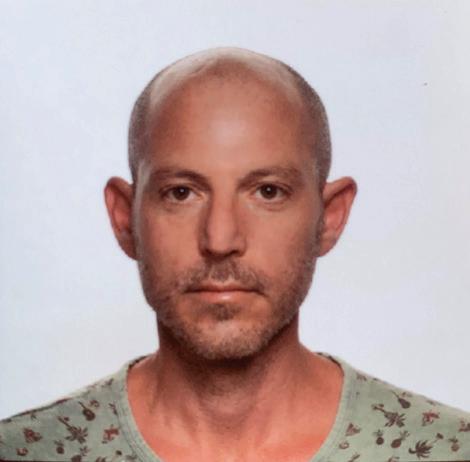
He collaborates with the Mooney Lab to engineer “antigen-presenting-cell mimetic scaffolds” (APCms)—3D biomaterials designed to expand rare, tumor-specific T cells. His work focuses on pediatric cancers driven by fusion proteins— potent oncogenic drivers absent in normal tissue, making them ideal targets for T cell immunotherapy. In a proof-of-concept study, Dr. Binenbaum successfully identified and cloned a TCR targeting the EWS-FLI1 fusion protein in Ewing Sarcoma, showing selective tumor cell killing in vitro. He is now expanding this approach to other fusion-driven malignancies such as ependymoma.
Preterm birth affects approximately 10% of all pregnancies and remains a leading cause of death and disability in children under five years of age(1). Despite the severity of the problem, there are currently no effective treatments to prevent preterm labor. One reason for the slow progress in developing more effective therapies is the lack of physiologically relevant models of human labor.
The cervix, forming the lower part of the uterus, plays a crucial role in maintaining pregnancy. Premature cervical shortening is currently the only clinically recognized predictor of preterm labor. Although labor is a complex syndrome(1), infection is implicated in approximately 40% of cases. In particular, recent studies have linked a dysbiotic vaginal
Dr. Anna Stejskalova is currently a postdoctoral researcher in the Laboratory of Dr. Ingber at the Wyss Institute at Harvard Medical School where she is developing organ chip models of the female reproductive tract to study preterm labor and other conditions. Prior to joining the Wyss Institute, Anna was a Fellow at WWU Munster in the laboratory of Dr.
microbiome to an increased risk of preterm labor, whereas the dominance of Lactobacillus crispatus is associated with term birth(2).
To investigate how microbiome and associated inflammation modulate the risk of human cervix dysfunction, we developed a human Endocervix Chip model composed of primary endocervical epithelial cells interfaced with stromal cells. This biomimetic system recapitulates key features of cervical dysfunction, including mucus plug alterations and extracellular matrix remodeling. We demonstrate that this preclinical platform can be used to assess the efficacy of both existing and novel therapeutic strategies aimed at preventing cervical shortening and, ultimately, preterm labor.
Gotte in Germany working on Endometriosis and has a Ph.D. in Bioengineering from Imperial College London. Anna is also a cofounder of the non-profit Czexpats in Science.
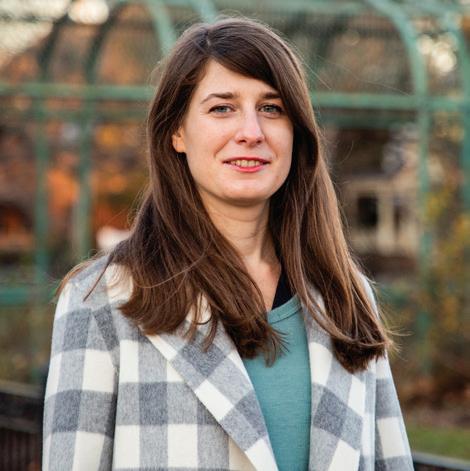
Every newborn deserves a gentle start to life. But for over 50,000 babies born every year with neonatal opioid withdrawal syndrome (NOWS), their start is marked by tremors, sweating, and inconsolable cries. These infants, exposed to opioids in the womb, depend on overburdened caregivers to soothe their suffering. The firstyear healthcare costs for these babies is $33,886 compared to $11,727 for healthy newborns. At Prapela, we are reducing these costs and more importantly directly supporting caregivers and the most vulnerable among us—opioid-exposed newborns.
Now, for the first time, hospitals across the country have access to a non-pharmacological, FDA-authorized treatment option. On April 4, 2025, the U.S. Food and Drug Administration granted De Novo classification to the Prapela SVS hospital bassinet pad, making it the first and only medical device approved to treat opioid-exposed newborns with NOWS.
CEO & Co-founder, Prapela, Inc.
I am honored to have created and now lead Prapela, America’s most-awarded Pediatric Medical Device startup. At Prapela, we focus on our applying our non-invasive stimulation therapy to improve and stabilize dysregulated breathing, heart rate and body movements in newborns.
On April 4, 2025, the Prapela SVS hospital bassinet pad was granted FDA De Novo marketing authorization to improve the treatment of opioidexposed newborns - our first indication. Our most recent FDA breakthrough device designation is aimed at reducing apneic and hypoxic events in preterm newborns. Since 2018, Prapela has been awarded over $8.3M of non-dilutive grants. Previously, five of the Top 25 Medical Device
Across the country, the “Eat, Sleep, Console” (ESC) model is widely used, prioritizing swaddling, rocking and skin-to-skin contact. But this standard of care, while effective, is resourceintensive—creating additional burdens especially in understaffed and rural settings. The Prapela SVS pad integrates seamlessly into ESC programs, replacing the mattress in existing medical bassinets, delivering a gentle vibration therapy that calms distressed infants.
Based on the clinical trial supporting our De Novo authorization, the Prapela SVS pad: reduces length of hospital stay, decreases the number of newborns requiring morphine or methadone, and provides a helpful option, boosting morale for mothers and clinical staff providing supportive care.
In the face of the opioid epidemic, this project brings relief, resilience, and hope—to babies, to families, and caregivers who stand by them. For more information visit www.prapela.com.

companies in the world trusted me in leadership and executive roles. I led or assisted in generating over $5.4 billion in revenue and launched over 100 new products. My experience includes work in Medical devices, Diagnostics, Medical Imaging, Durable Medical Equipment, Biologics, Wearables, Genetic testing, and Consumer products markets. I have worked closely with physicians, nurses, therapists, and leaders in Neonatology, Orthopedics, Pain Management, OB/GYN, and Cardiology specialties. As a 2X CEO, my operational experience includes general management, marketing, sales, finance, HR, operations, R&D/product development, clinical research, quality, and regulatory affairs.
Dr. Artzi’s team has developed innovative microneedle (MN) technologies for minimally invasive biomarker sampling and targeted therapeutic delivery, with an emphasis on pediatric applications. Her work addresses key clinical challenges associated with traditional diagnostic and treatment methods in children—such as pain, invasiveness, and limited compliance—by engineering polymeric microneedles capable of both delivering immunomodulatory agents and collecting interstitial skin fluid (ISF) for biomarker analysis. These dual-function MN platforms enable localized administration of compounds like CpG oligodeoxynucleotides while simultaneously sampling inflammatory biomarkers, including IL-4, IL-13, and IFN- ᵧ. This approach allows for real-time monitoring of disease progression and therapeutic efficacy.
Designed with comfort and ease of use in mind, these microneedle systems have demonstrated potential in clinical settings such as alopecia areata and skin cancer, paving the way for more
A Pioneer in Structural Nanomedicine
Professor Natalie Artzi is a distinguished biomedical scientist and engineer whose groundbreaking work in structural nanomedicine is reshaping therapeutic and diagnostic strategies. Her research centers on engineering nanostructures with precise molecular and cellular architectures, enabling targeted, responsive, and effective treatment delivery. A leader in the development of tissue- and cell-responsive materials, Artzi has pioneered systems that react to chemical cues—creating a “depot effect” for localized, sustained therapeutic release, especially in immune modulation.
As Head of Structural Nanomedicine at the Gene and Cell Therapy Institute at Harvard Medical School, Artzi also co-leads Harvard’s first ARPA-H grant, focused on next-generation immunotherapies. Her lab has developed immune-
personalized, responsive, and child-friendly care. Dr. Artzi and her team have specifically developed MN patches composed of crosslinked hyaluronic acid—a biocompatible polymer—with a porous architecture that permits cellular infiltration. This design supports localized drug delivery and enables the analysis of recruited immune cells upon patch retrieval. Importantly, the microneedles feature on-demand degradation, which is essential for real-time therapeutic monitoring.
In a recent study, the team introduced a microneedle platform based on crosslinked hyaluronic acid for the transdermal delivery of CpG oligodeoxynucleotides, a TLR9 agonist used in cancer immunotherapy. In mouse models of melanoma and colon cancer, these MNs successfully induced anti-tumor immune responses and allowed for concurrent ISF sampling. This enabled the evaluation of immune cell populations and provided critical insights into therapeutic effectiveness, underscoring the platform’s utility in both treatment and real-time immune monitoring.
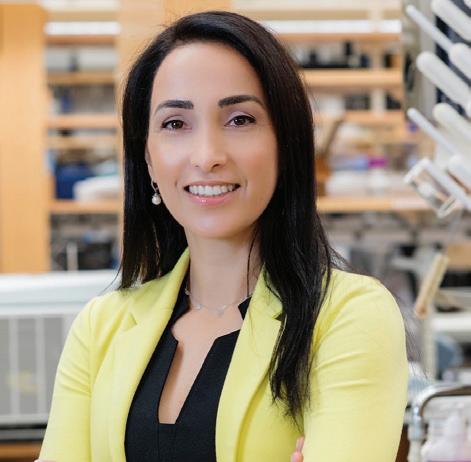
modulatory nanostructures that precisely activate immune cells, enhance therapeutic specificity, and shuttle drugs to targeted organs. These materials interact directly with cancer and immune cells to shape their phenotype and therapeutic response.
Artzi’s pioneering work has earned her numerous honors, including the 2024 Acta Biomaterialia Silver Medal, the 2024 Clemson Award for Applied Research, and the Society for Biomaterials MidCareer Award. She was the inaugural recipient of the Kabiller Rising Star Award in Nanomedicine and is a Fellow of both the American Institute for Medical and Biological Engineering (AIMBE) and the Controlled Release Society—affirming her status as a leading innovator in biomedical engineering.
When children thrive, societies thrive. Healthy children are the foundation of a healthy society. But our children are in jeopardy. Nearly half of our nation’s children have a chronic condition. One in five live in poverty, and more than 25 % have a behavioral health need. Upwards of half are covered by Medicaid and of those 59% have disabilities and government is retrenching.
Shifting demographics are creating increased concern. The number of seniors are expanding and the number of children are shrinking. As global birth rates fall below the replacement level, our focus should be on the well-being and development of the existing child population. Investing in innovative solutions for children such as advanced medical treatments, devices and digital health technologies is not only vital for their
CEO, Emerita, Boston Children’s Hospital
Sandra L. Fenwick is an accomplished corporate board member and visionary healthcare executive. Former CEO of Boston Children’s Hospital, she led the Hospital in advancing pediatric health care throughout the region and around the world, working to improve access to safe, quality care for all, and supporting the research and innovative partnerships required to lead the way in creating the future of care. She is a tireless advocate for children’s health and has been instrumental in developing strategies that position Boston Children’s as the scientific and thought leader in pediatric health. Boston Children’s is a 450bed Harvard teaching hospital with over $3B of revenues including $500M of research funding and 20,000 faculty and staff.
Sandra joined Boston Children’s in 1999, and was promoted to chief operating officer later that year. She added the position of president in 2008, and was named CEO in 2013. Prior to joining Boston Children’s, she worked for 20 years in operations, strategy and business development at Beth Israel
individual well-being but also for the long term stability and growth of economies worldwide.
Children are not small adults. Their unique anatomy, physiology, medical problems, metabolic reactions, psycho-social and demographic differences require research specifically designed for children. Today, the opportunity to harness the forces of medicine, science and technology is greater than ever. At the Wyss, we often lead and convene. We collaborate to discover and we convene to create a new standard of care. We are well positioned to realize this opportunity to advance the health and well-being of children in our communities and around the world. Remember, children are 25% of our population but 100% of our future.
Hospital and CareGroup, Inc. She holds a Bachelor of Science, with distinction in biology and chemistry, from Simmons University and a Masters in Public Health from the University of Texas School of Public Health.
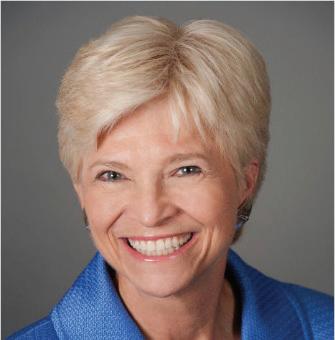
She currently serves on the Board of Directors of Teladoc Health, Inc., Risk Management Foundation of the Harvard Medical Institutions, Inc., Harvard’s Wyss Institute for Biologically-inspired Engineering, Patient Discovery Solutions, Inc., and BCH UK Charity, Ltd. She is also a member of the International Women’s Forum and Women Corporate Directors. She has received numerous awards for her contributions to healthcare and business including four honorary doctorates, the New England Council’s New Englander of the Year Award, the Greater Boston Chamber’s Pinnacle Award and was inducted into the Academy of Distinguished Bostonians. In 2021, she received the inaugural Helen Drinan Visionary Leadership Award from Simmons University.